EXHIBIT (c)(x)
The Queensland Government Document Entitled
“The Strongest & Smartest Choice:
Queensland’s Plan for Secure Finances and a Strong Economy”.
FORWARD-LOOKING STATEMENTS
This exhibit contains forward-looking statements. Statements that are not historical facts, including statements about the State of Queensland’s (the “State” or “Queensland”) beliefs and expectations, are forward-looking statements. These statements are based on current plans, budgets, estimates and projections and therefore you should not place undue reliance on them. The words “believe”, “may”, “will”, “should”, “estimate”, “continue”, “anticipate”, “intend”, “expect” and similar words are intended to identify forward-looking statements. Forward-looking statements speak only as of the date they are made, and neither the Queensland Treasury Corporation nor the State undertake any obligation to update publicly any of them in light of new information or future events.
Forward-looking statements are based on current plans, estimates and projections and, therefore, undue reliance should not be placed on them. Although the Queensland Treasury Corporation and the State believe that the beliefs and expectations reflected in such forward-looking statements are reasonable, no assurance can be given that such beliefs and expectations will prove to have been correct. Forward-looking statements involve inherent risks and uncertainties. We caution you that actual results may differ materially from those contained in any forward-looking statements.
A number of important factors could cause actual results to differ materially from those expressed in any forward-looking statement. Factors that could cause the actual outcomes to differ materially from those expressed or implied in forward-looking statements include:
| | • | | the international and Australian economies, and in particular the rates of growth (or contraction) of the State’s major trading partners; |
| | • | | the effects, both internationally and in Australia, of any further global financial crisis, any subsequent economic downturn, the ongoing economic, banking and sovereign debt crisis in Europe and any stalling of the protracted United States recovery; |
| | • | | increases or decreases in international and Australian domestic interest rates; |
| | • | | changes in the State’s domestic consumption; |
| | • | | changes in the State’s labor force participation and productivity; |
| | • | | downgrades in the credit ratings of the State and Australia; |
| | • | | changes in the rate of inflation in the State; |
| | • | | changes in environmental and other regulation; and |
| | • | | changes in the distribution of revenue from the Commonwealth of Australia Government to the State. |
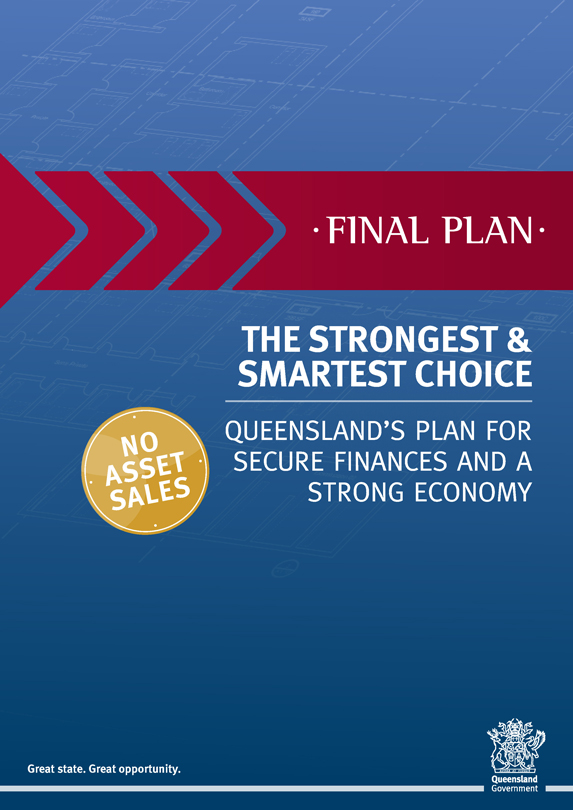
FINAL PLAN
THE STRONGEST & SMARTEST CHOICE
QUEENSLAND’S PLAN FOR SECURE FINANCES AND A STRONG ECONOMY
NO ASSET SALES
Great state. Great opportunity.
Queensland
Government
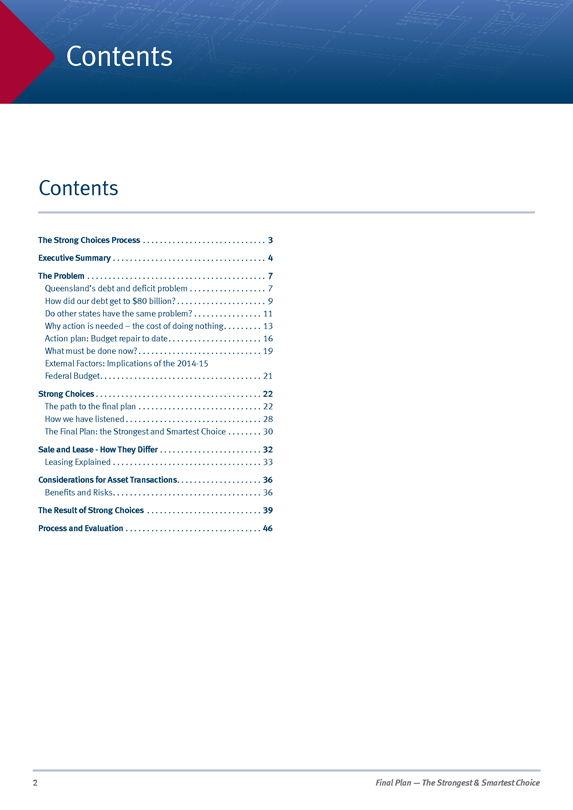
Contents
Contents
The Strong Choices Process 3
Executive Summary 4
The Problem 7
Queensland’s debt and deficit problem 7
How did our debt get to $80 billion? 9
Do other states have the same problem? 11
Why action is needed - the cost of doing nothing 13
Action plan: Budget repair to date 16
What must be done now? 19
External Factors: Implications of the 2014-15
Federal Budget 21
Strong Choices 22
The path to the final plan 22
How we have listened 28
The Final Plan: the Strongest and Smartest Choice 30
Sale and Lease - How They Differ 32
Leasing Explained 33
Considerations for Asset Transactions 36
Benefits and Risks 36
The Result of Strong Choices 39
Process and Evaluation 46
2
Final Plan – The Strongest & Smartest Choice
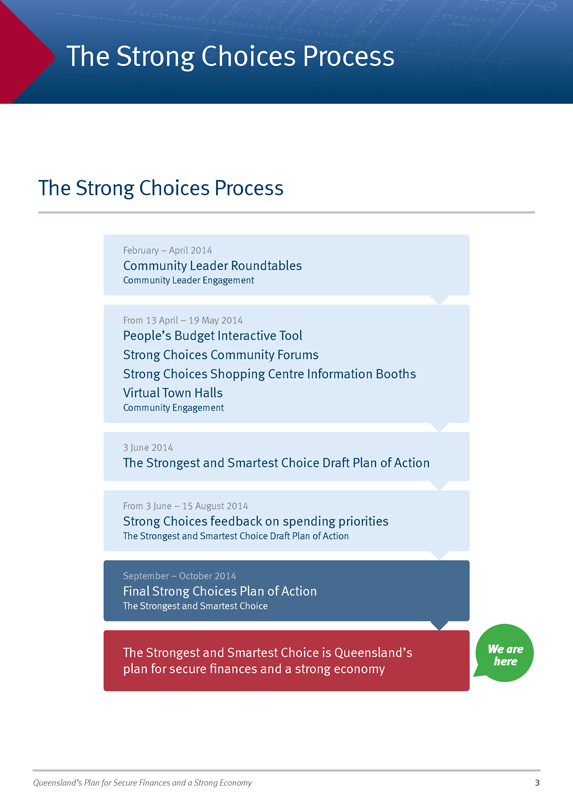
The Strong Choices Process
The Strong Choices Process
February - April 2014
Community Leader Roundtables
Community Leader Engagement
From 13 April - 19 May 2014
People’s Budget Interactive Tool
Strong Choices Community Forums
Strong Choices Shopping Centre Information Booths
Virtual Town Halls
Community Engagement
3 June 2014
The Strongest and Smartest Choice Draft Plan of Action
From 3 June - 15 August 2014
Strong Choices feedback on spending priorities
The Strongest and Smartest Choice Draft Plan of Action
September - October 2014
Final Strong Choices Plan of Action
The Strongest and Smartest Choice
The Strongest and Smartest Choice is Queensland’s plan for secure finances and a strong economy
We are here
Queensland’s Plan for Secure Finances and a Strong Economy
3
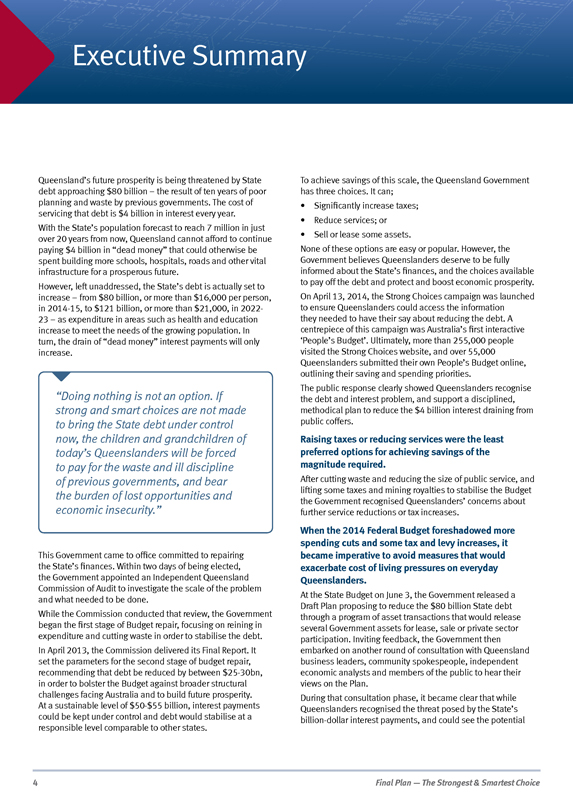
Executive Summary
Queensland’s future prosperity is being threatened by State debt approaching $80 billion - the result of ten years of poor planning and waste by previous governments. The cost of servicing that debt is $4 billion in interest every year.
With the State’s population forecast to reach 7 million in just over 20 years from now, Queensland cannot afford to continue paying $4 billion in “dead money” that could otherwise be spent building more schools, hospitals, roads and other vital infrastructure for a prosperous future.
However, left unaddressed, the State’s debt is actually set to increase - from $80 billion, or more than $16,000 per person, in 2014-15, to $121 billion, or more than $21,000, in 2022-23 - as expenditure in areas such as health and education increase to meet the needs of the growing population. In turn, the drain of “dead money” interest payments will only increase.
“Doing nothing is not an option. If strong and smart choices are not made to bring the State debt under control now, the children and grandchildren of today’s Queenslanders will be forced to pay for the waste and ill discipline of previous governments, and bear the burden of lost opportunities and economic insecurity.”
This Government came to office committed to repairing the State’s finances. Within two days of being elected, the Government appointed an Independent Queensland Commission of Audit to investigate the scale of the problem and what needed to be done.
While the Commission conducted that review, the Government began the first stage of Budget repair, focusing on reining in expenditure and cutting waste in order to stabilise the debt.
In April 2013, the Commission delivered its Final Report. It set the parameters for the second stage of budget repair, recommending that debt be reduced by between $25-30bn, in order to bolster the Budget against broader structural challenges facing Australia and to build future prosperity.
At a sustainable level of $50-$55 billion, interest payments could be kept under control and debt would stabilise at a responsible level comparable to other states.
To achieve savings of this scale, the Queensland Government has three choices. It can;
Significantly increase taxes;
Reduce services; or
Sell or lease some assets.
None of these options are easy or popular. However, the Government believes Queenslanders deserve to be fully informed about the State’s finances, and the choices available to pay off the debt and protect and boost economic prosperity.
On April 13, 2014, the Strong Choices campaign was launched to ensure Queenslanders could access the information they needed to have their say about reducing the debt. A centrepiece of this campaign was Australia’s first interactive ‘People’s Budget’. Ultimately, more than 255,000 people visited the Strong Choices website, and over 55,000 Queenslanders submitted their own People’s Budget online, outlining their saving and spending priorities.
The public response clearly showed Queenslanders recognise the debt and interest problem, and support a disciplined, methodical plan to reduce the $4 billion interest draining from public coffers.
Raising taxes or reducing services were the least preferred options for achieving savings of the magnitude required.
After cutting waste and reducing the size of public service, and lifting some taxes and mining royalties to stabilise the Budget the Government recognised Queenslanders’ concerns about further service reductions or tax increases.
When the 2014 Federal Budget foreshadowed more spending cuts and some tax and levy increases, it became imperative to avoid measures that would exacerbate cost of living pressures on everyday Queenslanders.
At the State Budget on June 3, the Government released a Draft Plan proposing to reduce the $80 billion State debt through a program of asset transactions that would release several Government assets for lease, sale or private sector participation. Inviting feedback, the Government then embarked on another round of consultation with Queensland business leaders, community spokespeople, independent economic analysts and members of the public to hear their views on the Plan.
During that consultation phase, it became clear that while Queenslanders recognised the threat posed by the State’s billion-dollar interest payments, and could see the potential
Final Plan – The Strongest & Smartest Choice
4
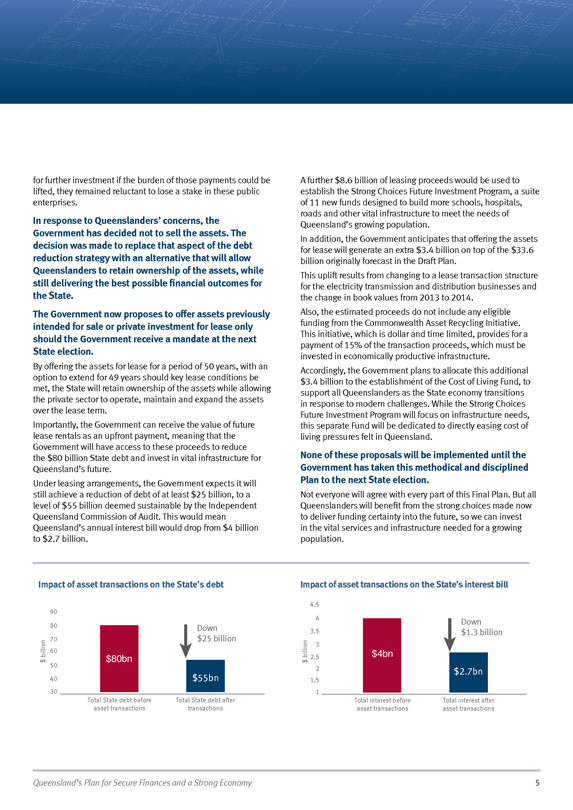
for further investment if the burden of those payments could be lifted, they remained reluctant to lose a stake in these public enterprises.
In response to Queenslanders’ concerns, the Government has decided not to sell the assets. The decision was made to replace that aspect of the debt reduction strategy with an alternative that will allow Queenslanders to retain ownership of the assets, while still delivering the best possible financial outcomes for the State.
The Government now proposes to offer assets previously intended for sale or private investment for lease only should the Government receive a mandate at the next State election.
By offering the assets for lease for a period of 50 years, with an option to extend for 49 years should key lease conditions be met, the State will retain ownership of the assets while allowing the private sector to operate, maintain and expand the assets over the lease term.
Importantly, the Government can receive the value of future lease rentals as an upfront payment, meaning that the Government will have access to these proceeds to reduce the $80 billion State debt and invest in vital infrastructure for Queensland’s future.
Under leasing arrangements, the Government expects it will still achieve a reduction of debt of at least $25 billion, to a level of $55 billion deemed sustainable by the Independent Queensland Commission of Audit. This would mean Queensland’s annual interest bill would drop from $4 billion to $2.7 billion.
A further $8.6 billion of leasing proceeds would be used to establish the Strong Choices Future Investment Program, a suite of 11 new funds designed to build more schools, hospitals, roads and other vital infrastructure to meet the needs of Queensland’s growing population.
In addition, the Government anticipates that offering the assets for lease will generate an extra $3.4 billion on top of the $33.6 billion originally forecast in the Draft Plan.
This uplift results from changing to a lease transaction structure for the electricity transmission and distribution businesses and the change in book values from 2013 to 2014.
Also, the estimated proceeds do not include any eligible funding from the Commonwealth Asset Recycling Initiative.
This initiative, which is dollar and time limited, provides for a payment of 15% of the transaction proceeds, which must be invested in economically productive infrastructure.
Accordingly, the Government plans to allocate this additional $3.4 billion to the establishment of the Cost of Living Fund, to support all Queenslanders as the State economy transitions in response to modern challenges. While the Strong Choices Future Investment Program will focus on infrastructure needs, this separate Fund will be dedicated to directly easing cost of living pressures felt in Queensland.
None of these proposals will be implemented until the Government has taken this methodical and disciplined Plan to the next State election.
Not everyone will agree with every part of this Final Plan. But all Queenslanders will benefit from the strong choices made now to deliver funding certainty into the future, so we can invest in the vital services and infrastructure needed for a growing population.
Impact of asset transactions on the State’s debt
90
80
70
60
50
40
30
$ billion
$80bn
Down $25 billion
$55bn
Total State debt before asset transactions
Total State debt after transactions
Impact of asset transactions on the State’s interest bill
4.5
4
3.5
3
2.5
1.5
1
$ billion
$4bn
Down
$1.3 billion
$2.7bn
Total interest before asset transactions
Total interest after asset transactions
Queensland’s Plan for Secure Finances and a Strong Economy
5
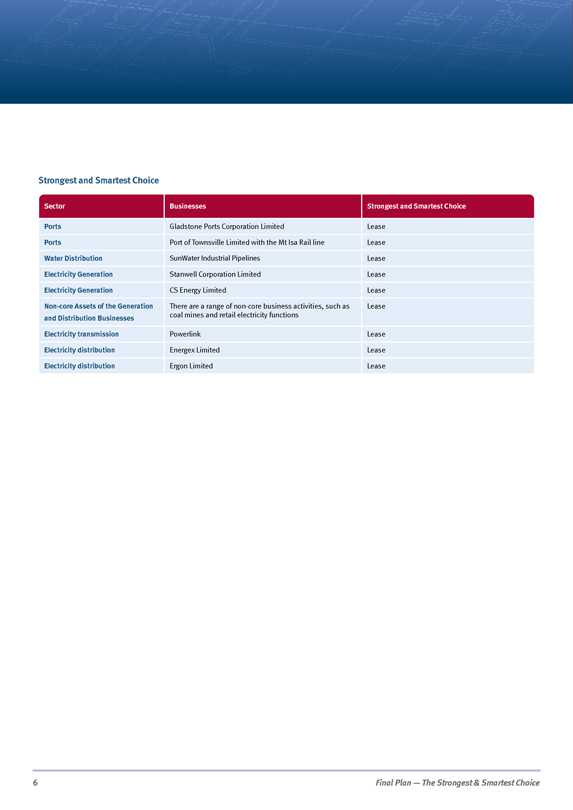
Strongest and Smartest Choice
Sector Businesses Strongest and Smartest Choice
Ports Gladstone Ports Corporation Limited Lease
Ports Port of Townsville Limited with the Mt Isa Rail line Lease
Water Distribution SunWater Industrial Pipelines Lease
Electricity Generation Stanwell Corporation Limited Lease
Electricity Generation CS Energy Limited Lease
Non-core Assets of the Generation and Distribution Businesses There are a range of non-core business activities, such as coal mines and retail electricity functions Lease
Electricity transmission Powerlink Lease
Electricity distribution Energex Limited Lease
Electricity distribution Ergon Limited Lease
Final Plan – The Strongest & Smartest Choice
6
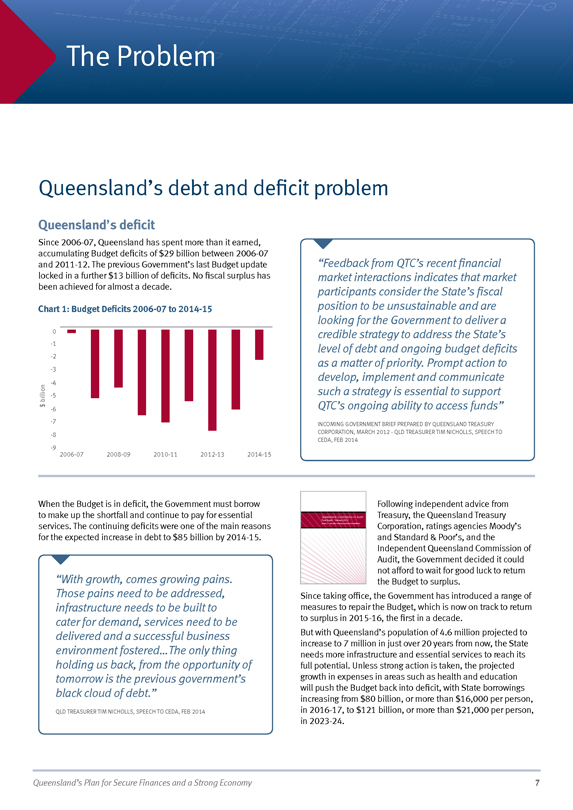
The Problem
Queensland’s debt and deficit problem
Queensland’s deficit
Since 2006-07, Queensland has spent more than it earned, accumulating Budget deficits of $29 billion between 2006-07 and 2011-12. The previous Government’s last Budget update locked in a further $13 billion of deficits. No fiscal surplus has been achieved for almost a decade.
Chart 1: Budget Deficits 2006-07 to 2014-15
$ billion
0
-1
-2
-3
-4
-5
-6
-7
-8
-9
2006-07 2008-09 2010-11 2012-13 2014-15
When the Budget is in deficit, the Government must borrow to make up the shortfall and continue to pay for essential services. The continuing deficits were one of the main reasons for the expected increase in debt to $85 billion by 2014-15.
“With growth, comes growing pains. Those pains need to be addressed, infrastructure needs to be built to cater for demand, services need to be delivered and a successful business environment fostered. The only thing holding us back, from the opportunity of tomorrow is the previous government’s black cloud of debt.”
QLD TREASURER TIM NICHOLLS, SPEECH TO CEDA, FEB 2014
“Feedback from QTC’s recent financial market interactions indicates that market participants consider the State’s fiscal position to be unsustainable and are looking for the Government to deliver a credible strategy to address the State’s level of debt and ongoing budget deficits as a matter of priority. Prompt action to develop, implement and communicate such a strategy is essential to support QTC’s ongoing ability to access funds”
INCOMING GOVERNMENT BRIEF PREPARED BY QUEENSLAND TREASURY CORPORATION, MARCH 2012 - QLD TREASURER TIM NICHOLLS, SPEECH TO CEDA, FEB 2014
Queensland Commission of Audit
Final Report - February 2013
Volume 1 - Executive Summary and Recommendations
Following independent advice from Treasury, the Queensland Treasury Corporation, ratings agencies Moody’s and Standard & Poor’s, and the Independent Queensland Commission of Audit, the Government decided it could not afford to wait for good luck to return the Budget to surplus.
Since taking office, the Government has introduced a range of measures to repair the Budget, which is now on track to return to surplus in 2015-16, the first in a decade.
But with Queensland’s population of 4.6 million projected to increase to 7 million in just over 20 years from now, the State needs more infrastructure and essential services to reach its full potential. Unless strong action is taken, the projected growth in expenses in areas such as health and education will push the Budget back into deficit, with State borrowings increasing from $80 billion, or more than $16,000 per person, in 2016-17, to $121 billion, or more than $21,000 per person, in 2023-24.
Queensland’s Plan for Secure Finances and a Strong Economy
7
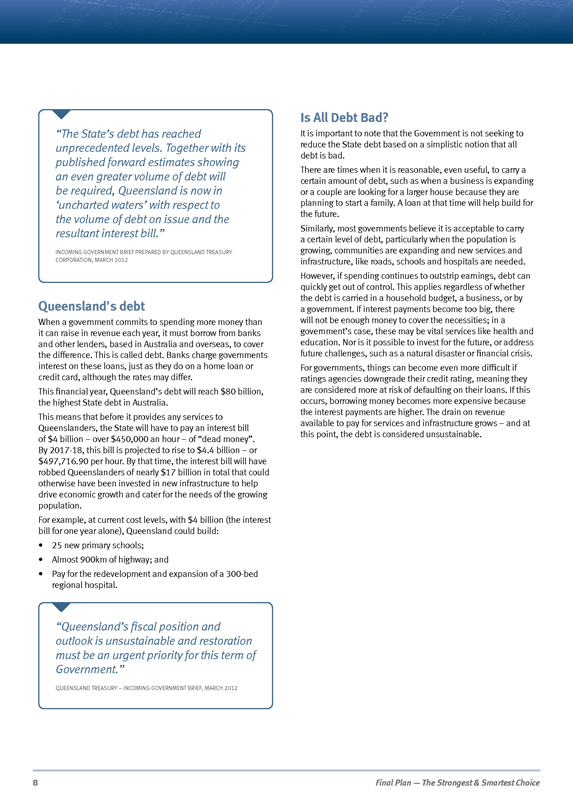
“The State’s debt has reached unprecedented levels. Together with its published forward estimates showing an even greater volume of debt will be required, Queensland is now in ‘uncharted waters’ with respect to the volume of debt on issue and the resultant interest bill.”
INCOMING GOVERNMENT BRIEF PREPARED BY QUEENSLAND TREASURY CORPORATION, MARCH 2012
Queensland’s debt
When a government commits to spending more money than it can raise in revenue each year, it must borrow from banks and other lenders, based in Australia and overseas, to cover the difference. This is called debt. Banks charge governments interest on these loans, just as they do on a home loan or credit card, although the rates may differ.
This financial year, Queensland’s debt will reach $80 billion, the highest State debt in Australia.
This means that before it provides any services to Queenslanders, the State will have to pay an interest bill of $4 billion - over $450,000 an hour - of “dead money”.
By 2017-18, this bill is projected to rise to $4.4 billion - or $497,716.90 per hour. By that time, the interest bill will have robbed Queenslanders of nearly $17 billion in total that could otherwise have been invested in new infrastructure to help drive economic growth and cater for the needs of the growing population.
For example, at current cost levels, with $4 billion (the interest bill for one year alone), Queensland could build:
25 new primary schools;
Almost 900km of highway; and
Pay for the redevelopment and expansion of a 300-bed regional hospital.
“Queensland’s fiscal position and outlook is unsustainable and restoration must be an urgent priority for this term of Government.”
QUEENSLAND TREASURY - INCOMING GOVERNMENT BRIEF, MARCH 2012
Is All Debt Bad?
It is important to note that the Government is not seeking to reduce the State debt based on a simplistic notion that all debt is bad.
There are times when it is reasonable, even useful, to carry a certain amount of debt, such as when a business is expanding or a couple are looking for a larger house because they are planning to start a family. A loan at that time will help build for the future.
Similarly, most governments believe it is acceptable to carry a certain level of debt, particularly when the population is growing, communities are expanding and new services and infrastructure, like roads, schools and hospitals are needed.
However, if spending continues to outstrip earnings, debt can quickly get out of control. This applies regardless of whether the debt is carried in a household budget, a business, or by a government. If interest payments become too big, there will not be enough money to cover the necessities; in a government’s case, these may be vital services like health and education. Nor is it possible to invest for the future, or address future challenges, such as a natural disaster or financial crisis.
For governments, things can become even more difficult if ratings agencies downgrade their credit rating, meaning they are considered more at risk of defaulting on their loans. If this occurs, borrowing money becomes more expensive because the interest payments are higher. The drain on revenue available to pay for services and infrastructure grows—and at this point, the debt is considered unsustainable.
Final Plan – The Strongest & Smartest Choice
8
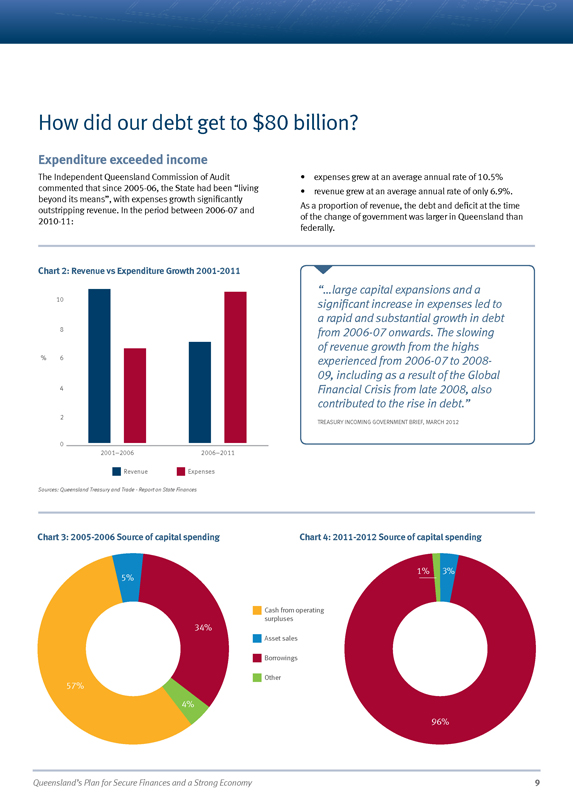
How did our debt get to $80 billion?
Expenditure exceeded income
The Independent Queensland Commission of Audit commented that since 2005-06, the State had been “living beyond its means”, with expenses growth significantly outstripping revenue. In the period between 2006-07 and 2010-11:
expenses grew at an average annual rate of 10.5%
revenue grew at an average annual rate of only 6.9%.
As a proportion of revenue, the debt and deficit at the time of the change of government was larger in Queensland than federally.
Chart 2: Revenue vs Expenditure Growth 2001-2011
%
10
8
6
4
2
0
2001-2006
2006-2011
Revenue
Expenses
Sources: Queensland Treasury and Trade - Report on State Finances
“...large capital expansions and a significant increase in expenses led to a rapid and substantial growth in debt from 2006-07 onwards. The slowing of revenue growth from the highs experienced from 2006-07 to 2008-09, including as a result of the Global Financial Crisis from late 2008, also contributed to the rise in debt.”
TREASURY INCOMING GOVERNMENT BRIEF, MARCH 2012
Chart 3: 2005-2006 Source of capital spending
5%
34%
57%
4%
Chart 4: 2011-2012 Source of capital spending
Cash from operating surpluses
Asset sales
Borrowings
Other
1%
3%
96%
Queensland’s Plan for Secure Finances and a Strong Economy
9
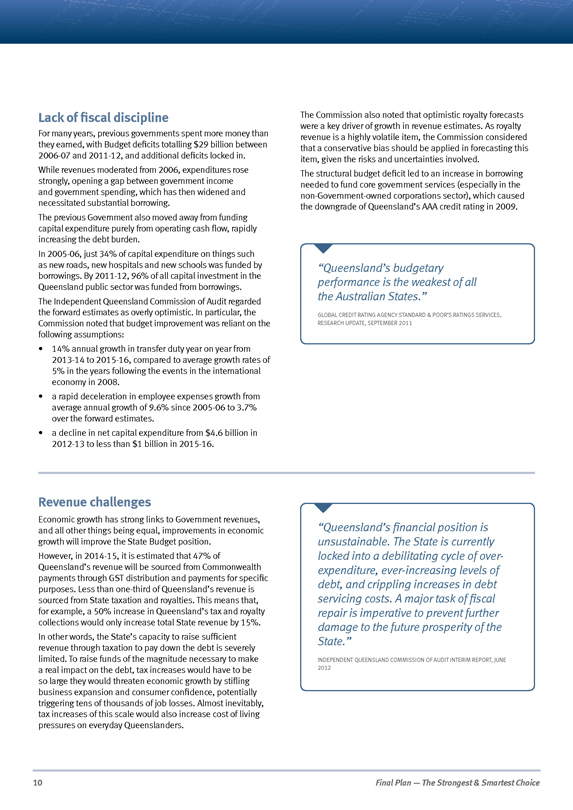
Lack of fiscal discipline
For many years, previous governments spent more money than they earned, with Budget deficits totalling $29 billion between 2006-07 and 2011-12, and additional deficits locked in.
While revenues moderated from 2006, expenditures rose strongly, opening a gap between government income and government spending, which has then widened and necessitated substantial borrowing.
The previous Government also moved away from funding capital expenditure purely from operating cash flow, rapidly increasing the debt burden.
In 2005-06, just 34% of capital expenditure on things such as new roads, new hospitals and new schools was funded by borrowings. By 2011-12, 96% of all capital investment in the Queensland public sector was funded from borrowings.
The Independent Queensland Commission of Audit regarded the forward estimates as overly optimistic. In particular, the Commission noted that budget improvement was reliant on the following assumptions:
14% annual growth in transfer duty year on year from 2013-14 to 2015-16, compared to average growth rates of 5% in the years following the events in the international economy in 2008.
a rapid deceleration in employee expenses growth from average annual growth of 9.6% since 2005-06 to 3.7% over the forward estimates.
a decline in net capital expenditure from $4.6 billion in 2012-13 to less than $1 billion in 2015-16.
The Commission also noted that optimistic royalty forecasts were a key driver of growth in revenue estimates. As royalty revenue is a highly volatile item, the Commission considered that a conservative bias should be applied in forecasting this item, given the risks and uncertainties involved.
The structural budget deficit led to an increase in borrowing needed to fund core government services (especially in the non-Government-owned corporations sector), which caused the downgrade of Queensland’s AAA credit rating in 2009.
“Queensland’s budgetary performance is the weakest of all the Australian States.”
GLOBAL CREDIT RATING AGENCY STANDARD & POOR’S RATINGS SERVICES, RESEARCH UPDATE, SEPTEMBER 2011
Revenue challenges
Economic growth has strong links to Government revenues, and all other things being equal, improvements in economic growth will improve the State Budget position.
However, in 2014-15, it is estimated that 47% of Queensland’s revenue will be sourced from Commonwealth payments through GST distribution and payments for specific purposes. Less than one-third of Queensland’s revenue is sourced from State taxation and royalties. This means that, for example, a 50% increase in Queensland’s tax and royalty collections would only increase total State revenue by 15%.
In other words, the State’s capacity to raise sufficient revenue through taxation to pay down the debt is severely limited. To raise funds of the magnitude necessary to make a real impact on the debt, tax increases would have to be so large they would threaten economic growth by stifling business expansion and consumer confidence, potentially triggering tens of thousands of job losses. Almost inevitably, tax increases of this scale would also increase cost of living pressures on everyday Queenslanders.
“Queensland’s financial position is unsustainable. The State is currently locked into a debilitating cycle of over-expenditure, ever-increasing levels of debt, and crippling increases in debt servicing costs. A major task of fiscal repair is imperative to prevent further damage to the future prosperity of the State.”
INDEPENDENT QUEENSLAND COMMISSION OF AUDIT INTERIM REPORT, JUNE 2012
Final Plan – The Strongest & Smartest Choice
10
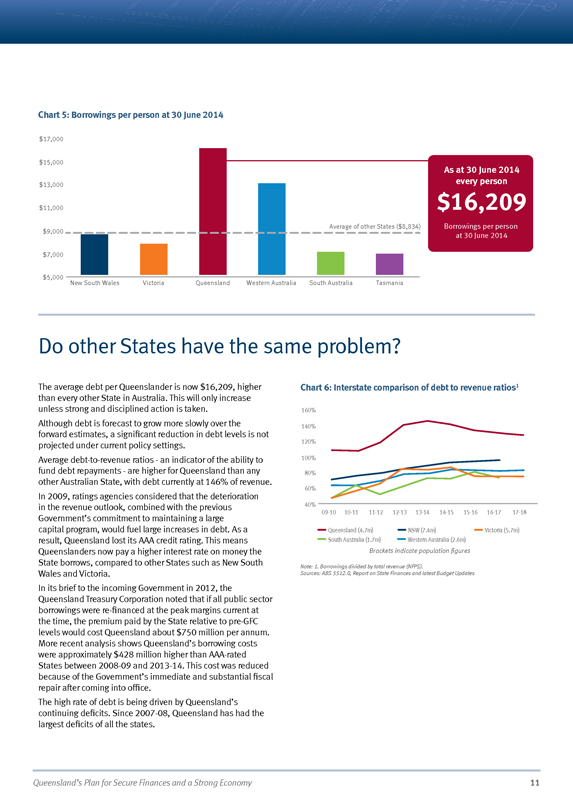
Chart 5: Borrowings per person at 30 June 2014
$17,000
$15,000
$13,000
$11,000
$9,000
$7,000
$5,000
New South Wales
Victoria
Queensland
Western Australia
South Australia
Tasmania
Average of other States ($8,834)
As at 30 June 2014 every person
$16,209
Borrowings per person at 30 June 2014
Do other States have the same problem?
The average debt per Queenslander is now $16,209, higher than every other State in Australia. This will only increase unless strong and disciplined action is taken.
Although debt is forecast to grow more slowly over the forward estimates, a significant reduction in debt levels is not projected under current policy settings.
Average debt-to-revenue ratios - an indicator of the ability to fund debt repayments - are higher for Queensland than any other Australian State, with debt currently at 146% of revenue.
In 2009, ratings agencies considered that the deterioration in the revenue outlook, combined with the previous Government’s commitment to maintaining a large capital program, would fuel large increases in debt. As a result, Queensland lost its AAA credit rating. This means Queenslanders now pay a higher interest rate on money the State borrows, compared to other States such as New South Wales and Victoria.
In its brief to the incoming Government in 2012, the Queensland Treasury Corporation noted that if all public sector borrowings were re-financed at the peak margins current at the time, the premium paid by the State relative to pre-GFC levels would cost Queensland about $750 million per annum. More recent analysis shows Queensland’s borrowing costs were approximately $428 million higher than AAA-rated States between 2008-09 and 2013-14. This cost was reduced because of the Government’s immediate and substantial fiscal repair after coming into office.
The high rate of debt is being driven by Queensland’s continuing deficits. Since 2007-08, Queensland has had the largest deficits of all the states.
Chart 6: Interstate comparison of debt to revenue ratios1
160%
140%
120%
100%
80%
60%
40%
09-10 10-11 11-12 12-13 13-14 14-15 15-16 16-17 17-18
Queensland (4.7m)
NSW (7.4m)
Victoria (5.7m)
South Australia (1.7m)
Western Australia (2.6m)
Brackets indicate population figures
Note: 1. Borrowings divided by total revenue (NFPS).
Sources: ABS 5512.0, Report on State Finances and latest Budget Updates
Queensland’s Plan for Secure Finances and a Strong Economy
11
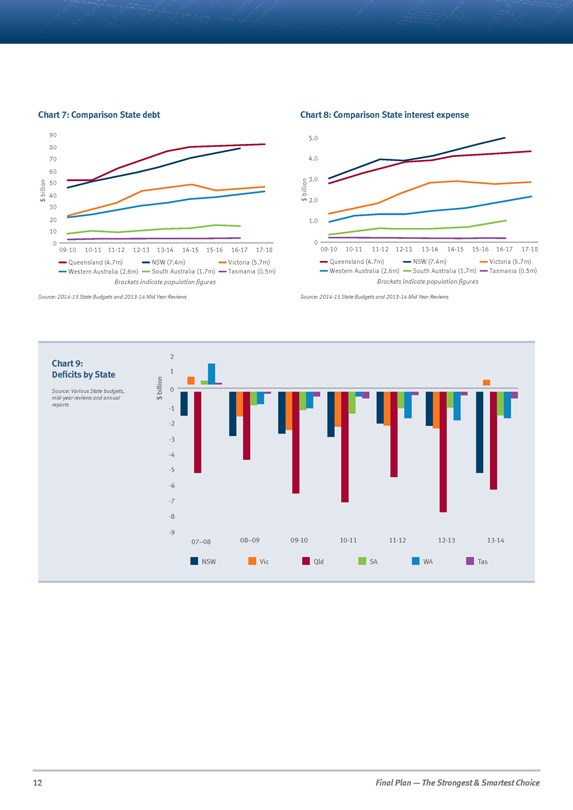
Chart 7: Comparison State debt
$ billion
90
80
70
60
50
40
30
20
10
0
09-10 10-11 11-12 12-13 13-14 14-15 15-16 16-17 17-18
Queensland (4.7m)
NSW (7.4m)
Victoria (5.7m)
Western Australia (2.6m)
South Australia (1.7m)
Tasmania (0.5m)
Brackets indicate population figures
Source: 2014-15 State Budgets and 2013-14 Mid Year Reviews
Chart 8: Comparison State interest expense
$ billion
5.0
4.0
3.0
2.0
1.0
0
09-10 10-11 11-12 12-13 13-14 14-15 15-16 16-17 17-18
Queensland (4.7m)
NSW (7.4m)
Victoria (5.7m)
Western Australia (2.6m)
South Australia (1.7m)
Tasmania (0.5m)
Brackets indicate population figures
Source: 2014-15 State Budgets and 2013-14 Mid Year Reviews
Chart 9:
Deficits by State
Source: Various State budgets,
mid-year reviews and annual reports
$ billion
2
1
0
-1
-2
-3
-4
-5
-6
-7
-8
-9
07-08 08-09 09-10 10-11 11-12 12-13 13-14
NSW
Vic
Qld
SA
WA
Tas
Final Plan – The Strongest & Smartest Choice
12
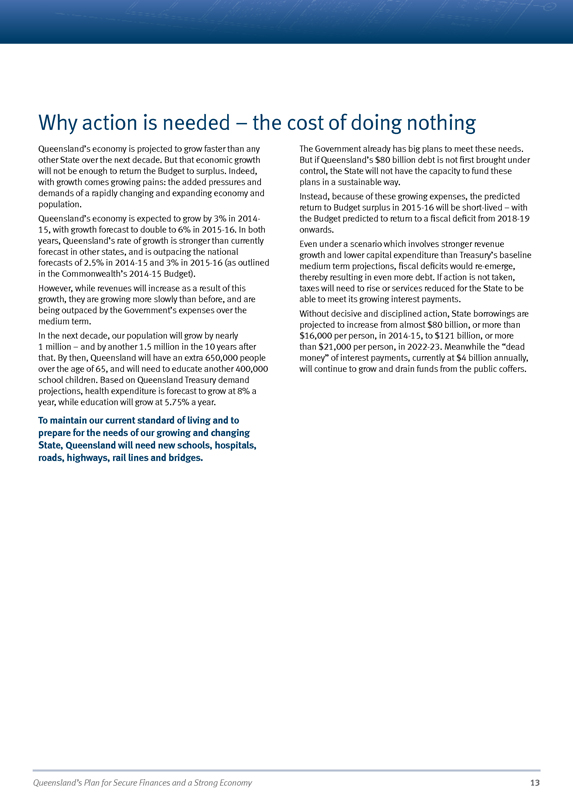
Why action is needed – the cost of doing nothing
Queensland’s economy is projected to grow faster than any other State over the next decade. But that economic growth will not be enough to return the Budget to surplus. Indeed, with growth comes growing pains: the added pressures and demands of a rapidly changing and expanding economy and population.
Queensland’s economy is expected to grow by 3% in 2014-15, with growth forecast to double to 6% in 2015-16. In both years, Queensland’s rate of growth is stronger than currently forecast in other states, and is outpacing the national forecasts of 2.5% in 2014-15 and 3% in 2015-16 (as outlined in the Commonwealth’s 2014-15 Budget).
However, while revenues will increase as a result of this growth, they are growing more slowly than before, and are being outpaced by the Government’s expenses over the medium term.
In the next decade, our population will grow by nearly 1 million – and by another 1.5 million in the 10 years after that. By then, Queensland will have an extra 650,000 people over the age of 65, and will need to educate another 400,000 school children. Based on Queensland Treasury demand projections, health expenditure is forecast to grow at 8% a year, while education will grow at 5.75% a year.
To maintain our current standard of living and to prepare for the needs of our growing and changing State, Queensland will need new schools, hospitals, roads, highways, rail lines and bridges.
The Government already has big plans to meet these needs. But if Queensland’s $80 billion debt is not first brought under control, the State will not have the capacity to fund these plans in a sustainable way.
Instead, because of these growing expenses, the predicted return to Budget surplus in 2015-16 will be short-lived – with the Budget predicted to return to a fiscal deficit from 2018-19 onwards.
Even under a scenario which involves stronger revenue growth and lower capital expenditure than Treasury’s baseline medium term projections, fiscal deficits would re-emerge, thereby resulting in even more debt. If action is not taken, taxes will need to rise or services reduced for the State to be able to meet its growing interest payments.
Without decisive and disciplined action, State borrowings are projected to increase from almost $80 billion, or more than $16,000 per person, in 2014-15, to $121 billion, or more than $21,000 per person, in 2022-23. Meanwhile the “dead money” of interest payments, currently at $4 billion annually, will continue to grow and drain funds from the public coffers.
Queensland’s Plan for Secure Finances and a Strong Economy
13
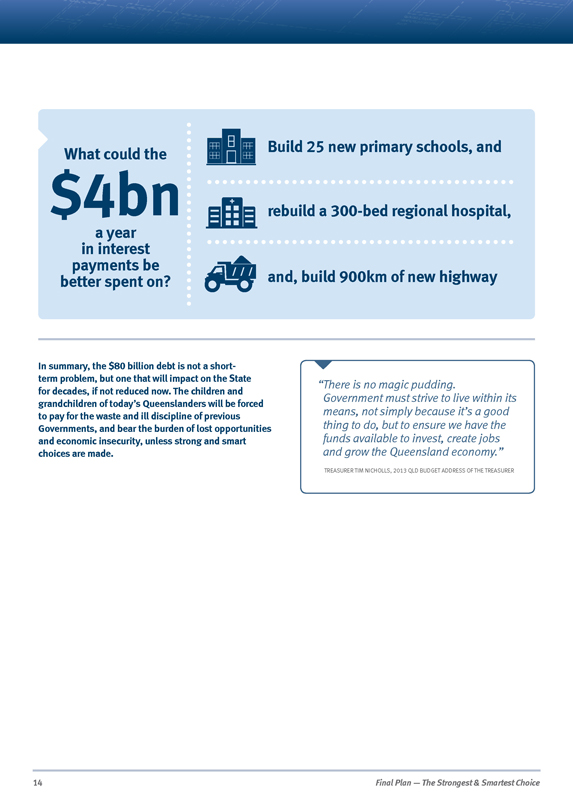
What could the
$4bn
a year in interest payments be better spent on?
Build 25 new primary schools, and
rebuild a 300-bed regional hospital,
and, build 900km of new highway
In summary, the $80 billion debt is not a short-term problem, but one that will impact on the State for decades, if not reduced now. The children and grandchildren of today’s Queenslanders will be forced to pay for the waste and ill discipline of previous Governments, and bear the burden of lost opportunities and economic insecurity, unless strong and smart choices are made.
“There is no magic pudding.
Government must strive to live within its means, not simply because it’s a good thing to do, but to ensure we have the funds available to invest, create jobs and grow the Queensland economy.”
TREASURER TIM NICHOLLS, 2013 QLD BUDGET ADDRESS OF THE TREASURER
Final Plan – The Strongest & Smartest Choice
14
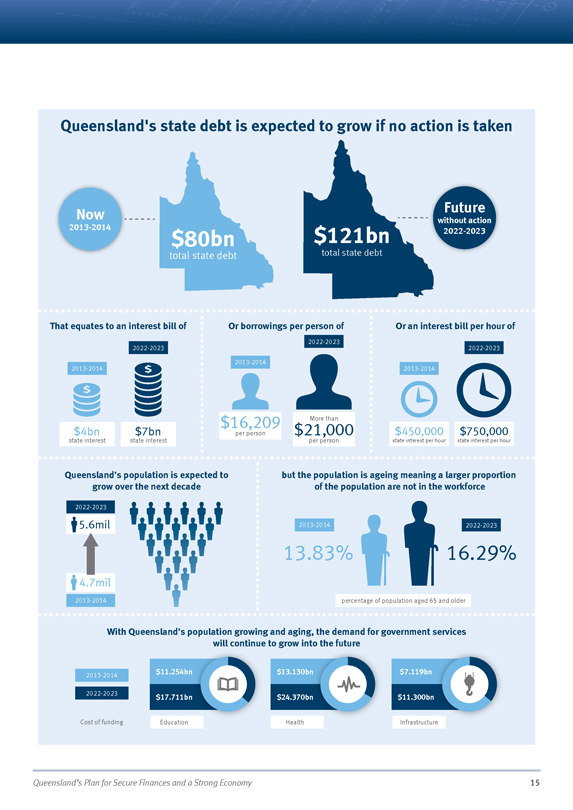
Queensland’s state debt is expected to grow if no action is taken
Now
2013-2014
$80bn
total state debt
$121bn
total state debt
Future
without action 2022-2023
That equates to an interest bill of
2013-2014
2022-2023
$4bn
state interest
$7bn
state interest
Or borrowings per person of
2013-2014
$16,209
per person
2022-2023
More than
$21,000
per person
Or an interest bill per hour of
2013-2014
$450,000
state interest per hour
2022-2023
$750,000
state interest per hour
Queensland’s population is expected to grow over the next decade
2022-2023
5.6mil
4.7mil
2013-2014
but the population is ageing meaning a larger proportion of the population are not in the workforce
2013-2014
13.83%
2022-2023
16.29%
percentage of population aged 65 and older
With Queensland’s population growing and aging, the demand for government services
will continue to grow into the future
2013-2014
2022-2023
Cost of funding
$11.254bn
$17.711bn
$13.130bn
$24.370bn
$7.119bn
$11.300bn
Education
Health
Infrastructure
Queensland’s Plan for Secure Finances and a Strong Economy
15
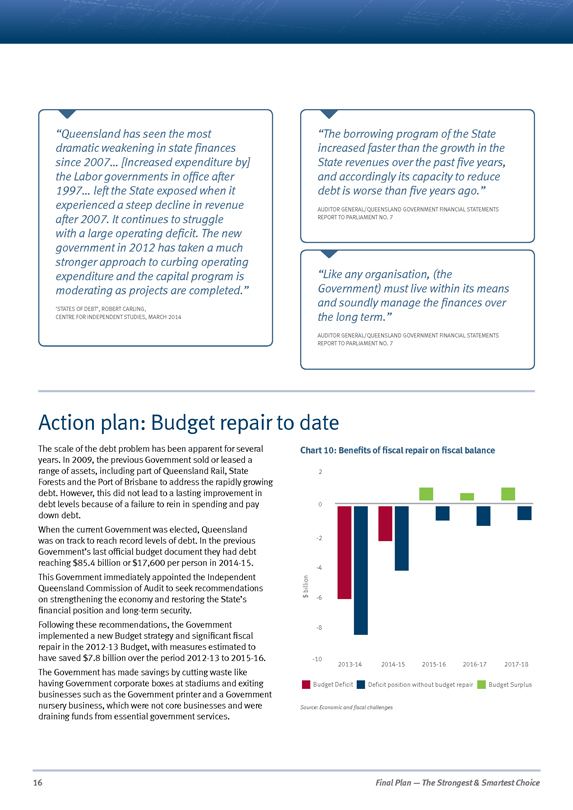
“Queensland has seen the most dramatic weakening in state finances since 2007... [Increased expenditure by] the Labor governments in office after 1997... left the State exposed when it experienced a steep decline in revenue after 2007. It continues to struggle with a large operating deficit. The new government in 2012 has taken a much stronger approach to curbing operating expenditure and the capital program is moderating as projects are completed.”
‘STATES OF DEBT’, ROBERT CARLING,
CENTRE FOR INDEPENDENT STUDIES, MARCH 2014
“The borrowing program of the State increased faster than the growth in the State revenues over the past five years, and accordingly its capacity to reduce debt is worse than five years ago.”
AUDITOR GENERAL/QUEENSLAND GOVERNMENT FINANCIAL STATEMENTS REPORT TO PARLIAMENT NO. 7
“Like any organisation, (the Government) must live within its means and soundly manage the finances over the long term.”
AUDITOR GENERAL/QUEENSLAND GOVERNMENT FINANCIAL STATEMENTS REPORT TO PARLIAMENT NO. 7
Action plan: Budget repair to date
The scale of the debt problem has been apparent for several years. In 2009, the previous Government sold or leased a range of assets, including part of Queensland Rail, State Forests and the Port of Brisbane to address the rapidly growing debt. However, this did not lead to a lasting improvement in debt levels because of a failure to rein in spending and pay down debt.
When the current Government was elected, Queensland was on track to reach record levels of debt. In the previous Government’s last official budget document they had debt reaching $85.4 billion or $17,600 per person in 2014-15.
This Government immediately appointed the Independent Queensland Commission of Audit to seek recommendations on strengthening the economy and restoring the State’s financial position and long-term security.
Following these recommendations, the Government implemented a new Budget strategy and significant fiscal repair in the 2012-13 Budget, with measures estimated to have saved $7.8 billion over the period 2012-13 to 2015-16.
The Government has made savings by cutting waste like having Government corporate boxes at stadiums and exiting businesses such as the Government printer and a Government nursery business, which were not core businesses and were draining funds from essential government services.
Chart 10: Benefits of fiscal repair on fiscal balance
$ billion
2
0
-2
-4
-6
-8
-10
2013-14 2014-15 2015-16 2016-17 2017-18
Budget Deficit
Deficit position without budget repair
Budget Surplus
Source: Economic and fiscal challenges
Final Plan – The Strongest & Smartest Choice
16
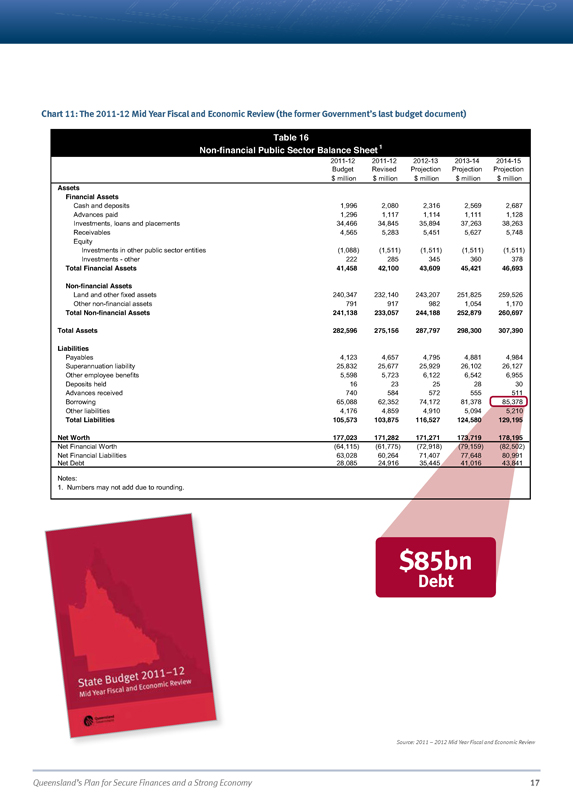
Chart 11: The 2011-12 Mid Year Fiscal and Economic Review (the former Government’s last budget document)
Table 16
Non-financial Public Sector Balance Sheet 1
2011-12 Budget $ million 2011-12 Revised $ million 2012-13 Projection $ million 2013-14 Projection $ million 2014-15 Projection $ million
Assets
Financial Assets
Cash and deposits 1,996 2,080 2,316 2,569 2,687
Advances paid 1,296 1,117 1,114 1,111 1,128
Investments, loans and placements 34,466 34,845 35,894 37,263 38,263
Receivables 4,565 5,283 5,451 5,627 5,748
Equity
Investments in other public sector entities (1,088) (1,511) (1,511) (1,511) (1,511)
Investments - other 222 285 345 360 378
Total Financial Assets 41,458 42,100 43,609 45,421 46,693
Non-financial Assets
Land and other fixed assets 240,347 232,140 243,207 251,825 259,526
Other non-financial assets 791 917 982 1,054 1,170
Total Non-financial Assets 241,138 233,057 244,188 252,879 260,697
Total Assets 282,596 275,156 287,797 298,300 307,390
Liabilities
Payables 4,123 4,657 4,795 4,881 4,984
Superannuation liability 25,832 25,677 25,929 26,102 26,127
Other employee benefits 5,598 5,723 6,122 6,542 6,955
Deposits held 16 23 25 28 30
Advances received 740 584 572 555 511
Borrowing 65,088 62,352 74,172 81,378 85,378
Other liabilities 4,176 4,859 4,910 5,094 5,210
Total Liabilities 105,573 103,875 116,527 124,580 129,195
Net Worth 177,023 171,282 171,271 173,719 178,195
Net Financial Worth (64,115) (61,775) (72,918) (79,159) (82,502)
Net Financial Liabilities 63,028 60,264 71,407 77,648 80,991
Net Debt 28,085 24,916 35,445 41,016 43,841
Notes:
1. Numbers may not add due to rounding.
State Budget 2011-12
Mid Year Fiscal and Economic Review
$85bn
Debt
Source: 2011 - 2012 Mid Year Fiscal and Economic Review
Queensland’s Plan for Secure Finances and a Strong Economy
17
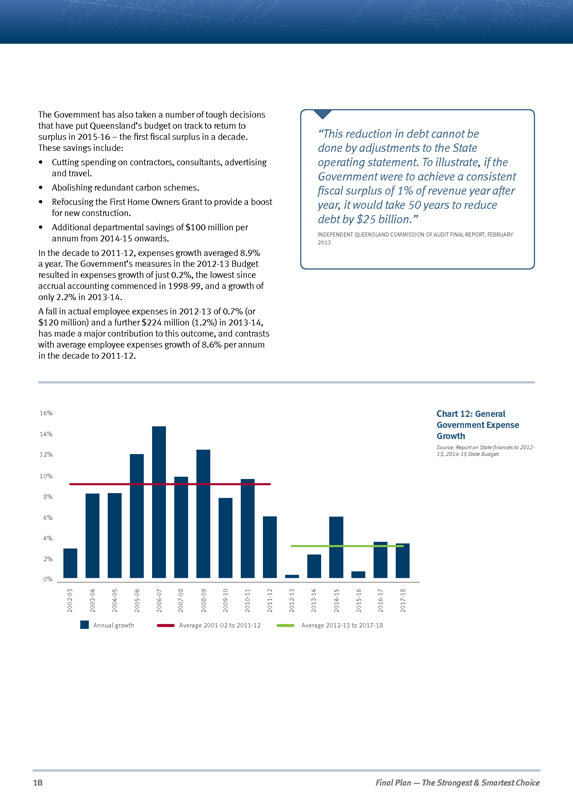
The Government has also taken a number of tough decisions that have put Queensland’s budget on track to return to surplus in 2015-16 – the first fiscal surplus in a decade.
These savings include:
Cutting spending on contractors, consultants, advertising and travel.
Abolishing redundant carbon schemes.
Refocusing the First Home Owners Grant to provide a boost for new construction.
Additional departmental savings of $100 million per annum from 2014-15 onwards.
In the decade to 2011-12, expenses growth averaged 8.9% a year. The Government’s measures in the 2012-13 Budget resulted in expenses growth of just 0.2%, the lowest since accrual accounting commenced in 1998-99, and a growth of only 2.2% in 2013-14.
A fall in actual employee expenses in 2012-13 of 0.7% (or $120 million) and a further $224 million (1.2%) in 2013-14, has made a major contribution to this outcome, and contrasts with average employee expenses growth of 8.6% per annum in the decade to 2011-12.
“This reduction in debt cannot be done by adjustments to the State operating statement. To illustrate, if the Government were to achieve a consistent fiscal surplus of 1% of revenue year after year, it would take 50 years to reduce debt by $25 billion.”
INDEPENDENT QUEENSLAND COMMISSION OF AUDIT FINAL REPORT, FEBRUARY 2013
16%
14%
12%
10%
8%
6%
4%
2%
0%
2002-03
2003-04
2004-05
2005-06
2006-07
2007-08
2008-09
2009-10
2010-11
2011-12
2012-13
2013-14
2014-15
2015-16
2016-17
2017-18
Annual growth
Average 2001-02 to 2011-12
Average 2012-13 to 2017-18
Chart 12: General Government Expense Growth
Source: Report on State finances to 2012-13, 2014-15 State Budget.
Final Plan – The Strongest & Smartest Choice
18
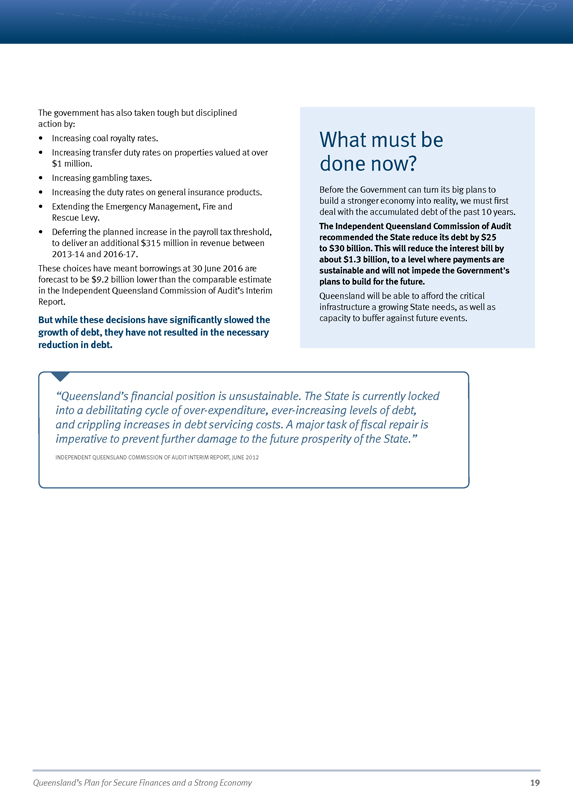
The government has also taken tough but disciplined action by:
Increasing coal royalty rates.
Increasing transfer duty rates on properties valued at over $1 million.
Increasing gambling taxes.
Increasing the duty rates on general insurance products.
Extending the Emergency Management, Fire and Rescue Levy.
Deferring the planned increase in the payroll tax threshold, to deliver an additional $315 million in revenue between 2013-14 and 2016-17.
These choices have meant borrowings at 30 June 2016 are forecast to be $9.2 billion lower than the comparable estimate in the Independent Queensland Commission of Audit’s Interim Report.
But while these decisions have significantly slowed the growth of debt, they have not resulted in the necessary reduction in debt.
What must be done now?
Before the Government can turn its big plans to build a stronger economy into reality, we must first deal with the accumulated debt of the past 10 years.
The Independent Queensland Commission of Audit recommended the State reduce its debt by $25 to $30 billion. This will reduce the interest bill by about $1.3 billion, to a level where payments are sustainable and will not impede the Government’s plans to build for the future.
Queensland will be able to afford the critical infrastructure a growing State needs, as well as capacity to buffer against future events.
“Queensland’s financial position is unsustainable. The State is currently locked into a debilitating cycle of over-expenditure, ever-increasing levels of debt, and crippling increases in debt servicing costs. A major task of fiscal repair is imperative to prevent further damage to the future prosperity of the State.”
INDEPENDENT QUEENSLAND COMMISSION OF AUDIT INTERIM REPORT, JUNE 2012
Queensland’s Plan for Secure Finances and a Strong Economy
19
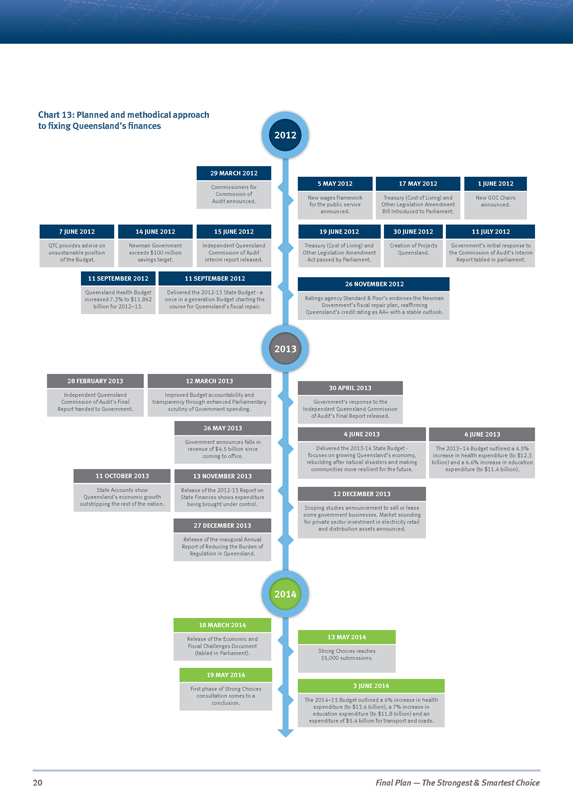
Chart 13: Planned and methodical approach to fixing Queensland’s finances
2012
29 MARCH 2012
Commissioners for Commission of Audit announced.
5 MAY 2012
New wages framework for the public service announced.
17 MAY 2012
Treasury (Cost of Living) and Other Legislation Amendment Bill Introduced to Parliament.
1 JUNE 2012
New GOC Chairs announced.
7 JUNE 2012
QTC provides advice on unsustainable position of the Budget.
14 JUNE 2012
Newman Government exceeds $100 million savings target.
15 JUNE 2012
Independent Queensland Commission of Audit interim report released.
19 JUNE 2012
Treasury (Cost of Living) and Other Legislation Amendment Act passed by Parliament.
30 JUNE 2012
Creation of Projects Queensland.
11 JULY 2012
Government’s initial response to the Commission of Audit’s Interim Report tabled in parliament.
11 SEPTEMBER 2012
Queensland Health Budget increased 7.3% to $11.862 billion for 2012-13.
11 SEPTEMBER 2012
Delivered the 2012-13 State Budget - a once in a generation Budget charting the course for Queensland’s fiscal repair.
26 NOVEMBER 2012
Ratings agency Standard & Poor’s endorses the Newman Government’s fiscal repair plan, reaffirming Queensland’s credit rating as AA+ with a stable outlook.
2013
28 FEBRUARY 2013
Independent Queensland Commission of Audit’s Final Report handed to Government.
12 MARCH 2013
Improved Budget accountability and transparency through enhanced Parliamentary scrutiny of Government spending.
30 APRIL 2013
Government’s response to the Independent Queensland Commission of Audit’s Final Report released.
26 MAY 2013
Government announces falls in revenue of $4.5 billion since coming to office.
4 JUNE 2013
Delivered the 2013-14 State Budget - focuses on growing Queensland’s economy, rebuilding after natural disasters and making communities more resilient for the future.
4 JUNE 2013
The 2013-14 Budget outlined a 4.5% increase in health expenditure (to $12.3 billion) and a 6.6% increase in education expenditure (to $11.4 billion).
11 OCTOBER 2013
State Accounts show Queensland’s economic growth outstripping the rest of the nation.
13 NOVEMBER 2013
Release of the 2012-13 Report on State Finances shows expenditure being brought under control.
12 DECEMBER 2013
Scoping studies announcement to sell or lease some government businesses. Market sounding for private sector investment in electricity retail and distribution assets announced.
27 DECEMBER 2013
Release of the inaugural Annual Report of Reducing the Burden of Regulation in Queensland.
2014
18 MARCH 2014
Release of the Economic and Fiscal Challenges Document (tabled in Parliament).
13 MAY 2014
Strong Choices reaches 55,000 submissions.
19 MAY 2014
First phase of Strong Choices consultation comes to a conclusion.
3 JUNE 2014
The 2014-15 Budget outlined a 6% increase in health expenditure (to $13.6 billion), a 7% increase in education expenditure (to $11.8 billion) and an expenditure of $5.4 billion for transport and roads.
Final Plan – The Strongest & Smartest Choice
20
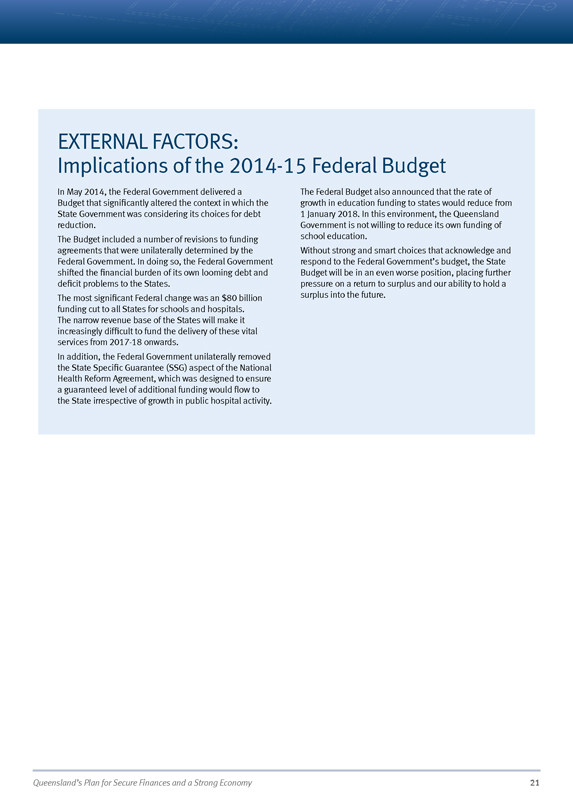
EXTERNAL FACTORS: Implications of the 2014-15 Federal Budget
In May 2014, the Federal Government delivered a Budget that significantly altered the context in which the State Government was considering its choices for debt reduction.
The Budget included a number of revisions to funding agreements that were unilaterally determined by the Federal Government. In doing so, the Federal Government shifted the financial burden of its own looming debt and deficit problems to the States.
The most significant Federal change was an $80 billion funding cut to all States for schools and hospitals.
The narrow revenue base of the States will make it increasingly difficult to fund the delivery of these vital services from 2017-18 onwards.
In addition, the Federal Government unilaterally removed the State Specific Guarantee (SSG) aspect of the National Health Reform Agreement, which was designed to ensure a guaranteed level of additional funding would flow to the State irrespective of growth in public hospital activity.
The Federal Budget also announced that the rate of growth in education funding to states would reduce from 1 January 2018. In this environment, the Queensland Government is not willing to reduce its own funding of school education.
Without strong and smart choices that acknowledge and respond to the Federal Government’s budget, the State Budget will be in an even worse position, placing further pressure on a return to surplus and our ability to hold a surplus into the future.
Queensland’s Plan for Secure Finances and a Strong Economy
21
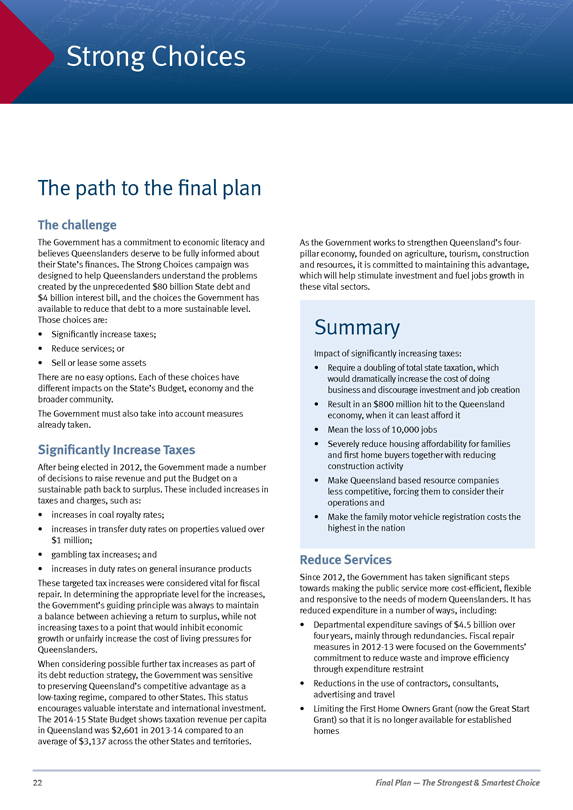
Strong Choices
The path to the final plan
The challenge
The Government has a commitment to economic literacy and believes Queenslanders deserve to be fully informed about their State’s finances. The Strong Choices campaign was designed to help Queenslanders understand the problems created by the unprecedented $80 billion State debt and $4 billion interest bill, and the choices the Government has available to reduce that debt to a more sustainable level. Those choices are:
Significantly increase taxes;
Reduce services; or
Sell or lease some assets
There are no easy options. Each of these choices have different impacts on the State’s Budget, economy and the broader community.
The Government must also take into account measures already taken.
Significantly Increase Taxes
After being elected in 2012, the Government made a number of decisions to raise revenue and put the Budget on a sustainable path back to surplus. These included increases in taxes and charges, such as:
increases in coal royalty rates;
increases in transfer duty rates on properties valued over $1 million;
gambling tax increases; and
increases in duty rates on general insurance products
These targeted tax increases were considered vital for fiscal repair. In determining the appropriate level for the increases, the Government’s guiding principle was always to maintain a balance between achieving a return to surplus, while not increasing taxes to a point that would inhibit economic growth or unfairly increase the cost of living pressures for Queenslanders.
When considering possible further tax increases as part of its debt reduction strategy, the Government was sensitive to preserving Queensland’s competitive advantage as a low-taxing regime, compared to other States. This status encourages valuable interstate and international investment. The 2014-15 State Budget shows taxation revenue per capita in Queensland was $2,601 in 2013-14 compared to an average of $3,137 across the other States and territories.
As the Government works to strengthen Queensland’s four-pillar economy, founded on agriculture, tourism, construction and resources, it is committed to maintaining this advantage, which will help stimulate investment and fuel jobs growth in these vital sectors.
Summary
Impact of significantly increasing taxes:
Require a doubling of total state taxation, which would dramatically increase the cost of doing business and discourage investment and job creation
Result in an $800 million hit to the Queensland economy, when it can least afford it
Mean the loss of 10,000 jobs
Severely reduce housing affordability for families and first home buyers together with reducing construction activity
Make Queensland based resource companies less competitive, forcing them to consider their operations and
Make the family motor vehicle registration costs the highest in the nation
Reduce Services
Since 2012, the Government has taken significant steps towards making the public service more cost-efficient, flexible and responsive to the needs of modern Queenslanders. It has reduced expenditure in a number of ways, including:
Departmental expenditure savings of $4.5 billion over four years, mainly through redundancies. Fiscal repair measures in 2012-13 were focused on the Governments’ commitment to reduce waste and improve efficiency through expenditure restraint
Reductions in the use of contractors, consultants, advertising and travel
Limiting the First Home Owners Grant (now the Great Start Grant) so that it is no longer available for established homes
Final Plan – The Strongest & Smartest Choice
22
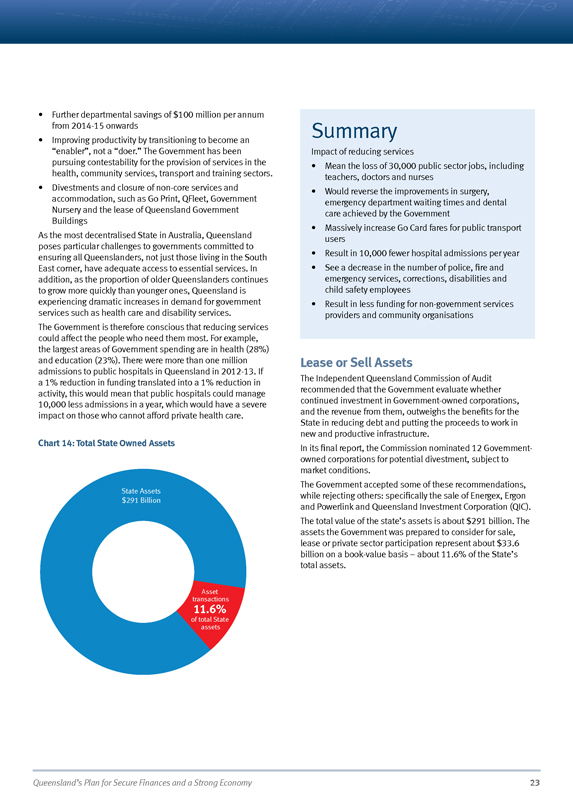
Further departmental savings of $100 million per annum from 2014-15 onwards
Improving productivity by transitioning to become an “enabler”, not a “doer.” The Government has been pursuing contestability for the provision of services in the health, community services, transport and training sectors.
Divestments and closure of non-core services and accommodation, such as Go Print, QFleet, Government Nursery and the lease of Queensland Government Buildings
As the most decentralised State in Australia, Queensland poses particular challenges to governments committed to ensuring all Queenslanders, not just those living in the South East corner, have adequate access to essential services. In addition, as the proportion of older Queenslanders continues to grow more quickly than younger ones, Queensland is experiencing dramatic increases in demand for government services such as health care and disability services.
The Government is therefore conscious that reducing services could affect the people who need them most. For example, the largest areas of Government spending are in health (28%) and education (23%). There were more than one million admissions to public hospitals in Queensland in 2012-13. If a 1% reduction in funding translated into a 1% reduction in activity, this would mean that public hospitals could manage 10,000 less admissions in a year, which would have a severe impact on those who cannot afford private health care.
Chart 14: Total State Owned Assets
State Assets $291 Billion
Asset transactions 11.6% of total State assets
Summary
Impact of reducing services
Mean the loss of 30,000 public sector jobs, including teachers, doctors and nurses
Would reverse the improvements in surgery, emergency department waiting times and dental care achieved by the Government
Massively increase Go Card fares for public transport users
Result in 10,000 fewer hospital admissions per year
See a decrease in the number of police, fire and emergency services, corrections, disabilities and child safety employees
Result in less funding for non-government services providers and community organisations
Lease or Sell Assets
The Independent Queensland Commission of Audit recommended that the Government evaluate whether continued investment in Government-owned corporations, and the revenue from them, outweighs the benefits for the State in reducing debt and putting the proceeds to work in new and productive infrastructure.
In its final report, the Commission nominated 12 Government-owned corporations for potential divestment, subject to market conditions.
The Government accepted some of these recommendations, while rejecting others: specifically the sale of Energex, Ergon and Powerlink and Queensland Investment Corporation (QIC).
The total value of the state’s assets is about $291 billion. The assets the Government was prepared to consider for sale, lease or private sector participation represent about $33.6 billion on a book-value basis – about 11.6% of the State’s total assets.
Queensland’s Plan for Secure Finances and a Strong Economy
23
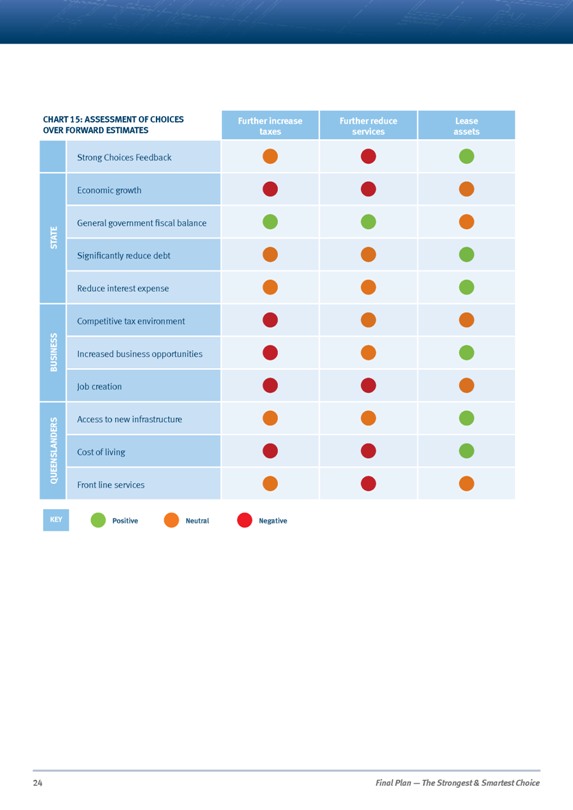
CHART 15: ASSESSMENT OF CHOICES OVER FORWARD ESTIMATES
Further increase taxes
Further reduce services
Lease assets
STATE
Strong Choices Feedback
Economic growth
General government fiscal balance
Significantly reduce debt
Reduce interest expense
BUSINESS
Competitive tax environment
Increased business opportunities
Job creation
QUEENSLANDERS
Access to new infrastructure
Cost of living
Front line services
KEY
Positive
Neutral
Negative
24 Final Plan – The Strongest & Smartest Choice
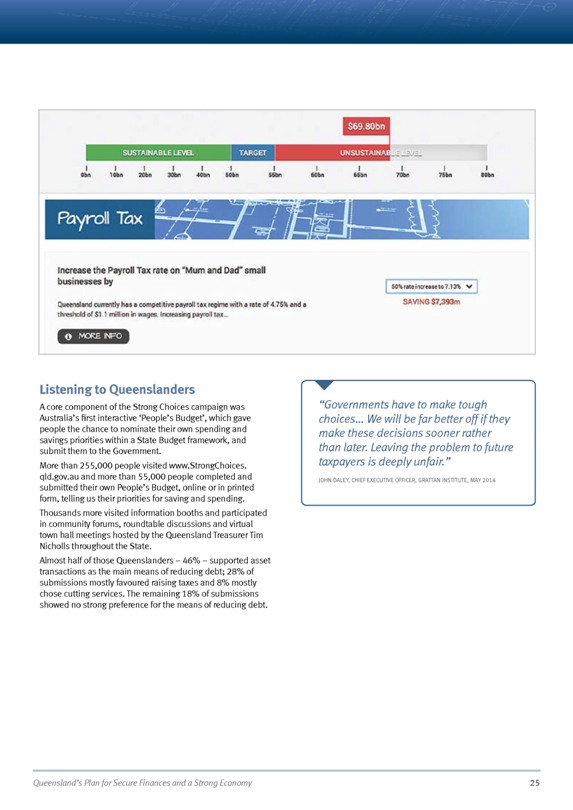
$69.80bn
SUSTAINABLE LEVEL
TARGET
UNSUSTAINABLE LEVEL
0bn
10bn
20bn
30bn
40bn
50bn
55bn
60bn
65bn
70bn
75bn
80bn
Payroll Tax
Increase the Payroll Tax rate on “Mum and Dad” small businesses by
Queensland currently has a competitive payroll tax regime with a rate of 4.75% and a threshold of $1.1 million in wages. Increasing payroll tax...
i MORE INFO
50% rate increase to 7.13%
SAVING $7,393m
Listening to Queenslanders
A core component of the Strong Choices campaign was Australia’s first interactive ‘People’s Budget’, which gave people the chance to nominate their own spending and savings priorities within a State Budget framework, and submit them to the Government.
More than 255,000 people visited www.StrongChoices. qld.gov.au and more than 55,000 people completed and submitted their own People’s Budget, online or in printed form, telling us their priorities for saving and spending.
Thousands more visited information booths and participated in community forums, roundtable discussions and virtual town hall meetings hosted by the Queensland Treasurer Tim Nicholls throughout the State.
Almost half of those Queenslanders – 46% – supported asset transactions as the main means of reducing debt; 28% of submissions mostly favoured raising taxes and 8% mostly chose cutting services. The remaining 18% of submissions showed no strong preference for the means of reducing debt.
“Governments have to make tough choices... We will be far better off if they make these decisions sooner rather than later. Leaving the problem to future taxpayers is deeply unfair.”
JOHN DALEY, CHIEF EXECUTIVE OFFICER, GRATTAN INSTITUTE, MAY 2014
Queensland’s Plan for Secure. Finances and a Strong Economy
25
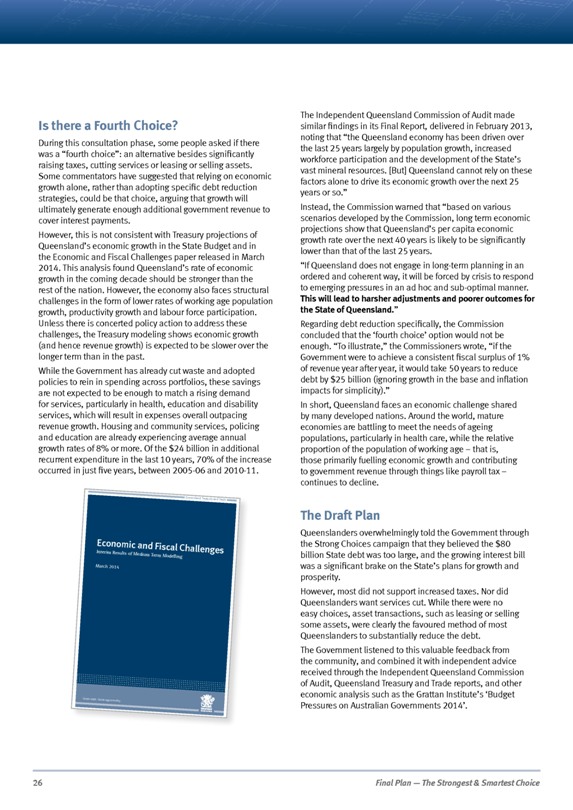
Is there a Fourth Choice?
During this consultation phase, some people asked if there was a “fourth choice”: an alternative besides significantly raising taxes, cutting services or leasing or selling assets. Some commentators have suggested that relying on economic growth alone, rather than adopting specific debt reduction strategies, could be that choice, arguing that growth will ultimately generate enough additional government revenue to cover interest payments.
However, this is not consistent with Treasury projections of Queensland’s economic growth in the State Budget and in the Economic and Fiscal Challenges paper released in March 2014. This analysis found Queensland’s rate of economic growth in the coming decade should be stronger than the rest of the nation. However, the economy also faces structural challenges in the form of lower rates of working age population growth, productivity growth and labour force participation. Unless there is concerted policy action to address these challenges, the Treasury modeling shows economic growth (and hence revenue growth) is expected to be slower over the longer term than in the past.
While the Government has already cut waste and adopted policies to rein in spending across portfolios, these savings are not expected to be enough to match a rising demand for services, particularly in health, education and disability services, which will result in expenses overall outpacing revenue growth. Housing and community services, policing and education are already experiencing average annual growth rates of 8% or more. Of the $24 billion in additional recurrent expenditure in the last 10 years, 70% of the increase occurred in just five years, between 2005-06 and 2010-11.
Economic and Fiscal Challenges
Interim Results of Medium Term Modelling
March 2014
The Independent Queensland Commission of Audit made similar findings in its Final Report, delivered in February 2013, noting that “the Queensland economy has been driven over the last 25 years largely by population growth, increased workforce participation and the development of the State’s vast mineral resources. [But] Queensland cannot rely on these factors alone to drive its economic growth over the next 25 years or so.”
Instead, the Commission warned that “based on various scenarios developed by the Commission, long term economic projections show that Queensland’s per capita economic growth rate over the next 40 years is likely to be significantly lower than that of the last 25 years.
“If Queensland does not engage in long-term planning in an ordered and coherent way, it will be forced by crisis to respond to emerging pressures in an ad hoc and sub-optimal manner. This will lead to harsher adjustments and poorer outcomes for the State of Queensland.”
Regarding debt reduction specifically, the Commission concluded that the ‘fourth choice’ option would not be enough. “To illustrate,” the Commissioners wrote, “if the Government were to achieve a consistent fiscal surplus of 1% of revenue year after year, it would take 50 years to reduce debt by $25 billion (ignoring growth in the base and inflation impacts for simplicity).”
In short, Queensland faces an economic challenge shared by many developed nations. Around the world, mature economies are battling to meet the needs of ageing populations, particularly in health care, while the relative proportion of the population of working age – that is, those primarily fuelling economic growth and contributing to government revenue through things like payroll tax – continues to decline.
The Draft Plan
Queenslanders overwhelmingly told the Government through the Strong Choices campaign that they believed the $80 billion State debt was too large, and the growing interest bill was a significant brake on the State’s plans for growth and prosperity.
However, most did not support increased taxes. Nor did Queenslanders want services cut. While there were no easy choices, asset transactions, such as leasing or selling some assets, were clearly the favoured method of most Queenslanders to substantially reduce the debt.
The Government listened to this valuable feedback from the community, and combined it with independent advice received through the Independent Queensland Commission of Audit, Queensland Treasury and Trade reports, and other economic analysis such as the Grattan Institute’s ‘Budget Pressures on Australian Governments 2014’.
26 Final Plan – The Strongest & Smartest Choice
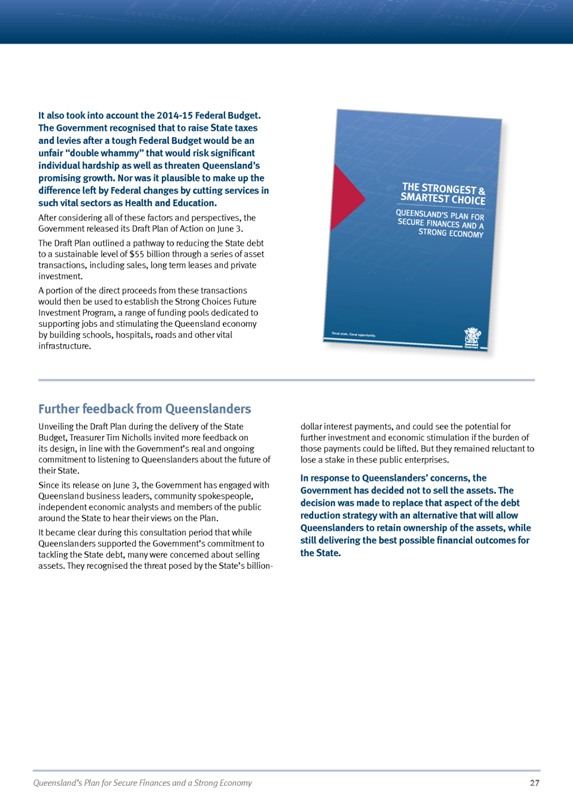
It also took into account the 2014-15 Federal Budget. The Government recognised that to raise State taxes and levies after a tough Federal Budget would be an unfair “double whammy” that would risk significant individual hardship as well as threaten Queensland’s promising growth. Nor was it plausible to make up the difference left by Federal changes by cutting services in such vital sectors as Health and Education.
After considering all of these factors and perspectives, the Government released its Draft Plan of Action on June 3.
The Draft Plan outlined a pathway to reducing the State debt to a sustainable level of $55 billion through a series of asset transactions, including sales, long term leases and private investment.
A portion of the direct proceeds from these transactions would then be used to establish the Strong Choices Future Investment Program, a range of funding pools dedicated to supporting jobs and stimulating the Queensland economy by building schools, hospitals, roads and other vital infrastructure.
THE STRONGEST & SMARTEST CHOICE
QUEENSLAND’S PLAN FOR SECURE FINANCES AND A STRONG ECONOMY
Great state. Great opportunity.
AUDAX AT FIDELIS
Queensland Government
Further feedback from Queenslanders
Unveiling the Draft Plan during the delivery of the State Budget, Treasurer Tim Nicholls invited more feedback on its design, in line with the Government’s real and ongoing commitment to listening to Queenslanders about the future of their State.
Since its release on June 3, the Government has engaged with Queensland business leaders, community spokespeople, independent economic analysts and members of the public around the State to hear their views on the Plan.
It became clear during this consultation period that while Queenslanders supported the Government’s commitment to tackling the State debt, many were concerned about selling assets. They recognised the threat posed by the State’s billion-dollar interest payments, and could see the potential for further investment and economic stimulation if the burden of those payments could be lifted. But they remained reluctant to lose a stake in these public enterprises.
In response to Queenslanders’ concerns, the Government has decided not to sell the assets. The decision was made to replace that aspect of the debt reduction strategy with an alternative that will allow Queenslanders to retain ownership of the assets, while still delivering the best possible financial outcomes for the State.
Queensland’s Plan for Secure Finances and a Strong Economy
27
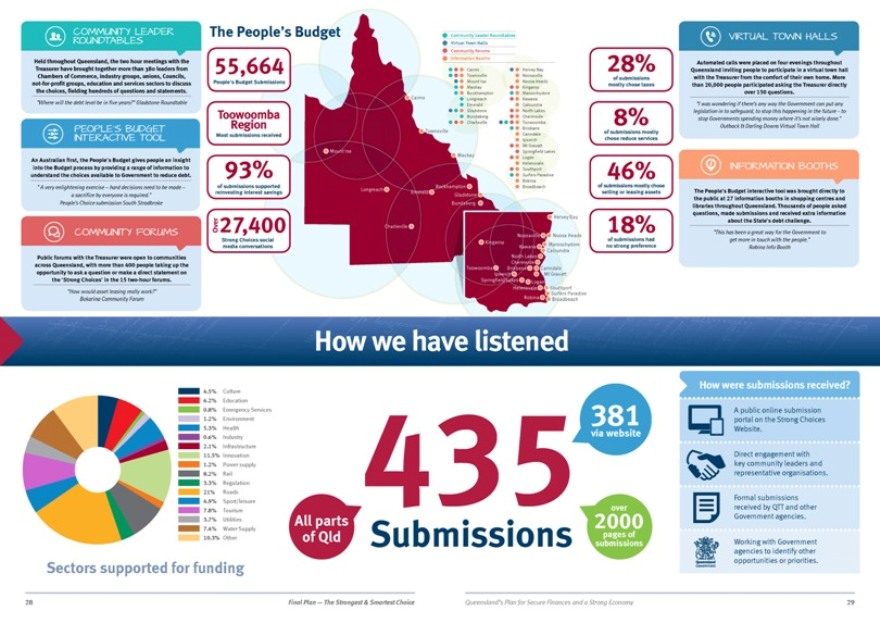
COMMUNITY LEADER ROUNDTABLES
Held throughout Queensland, the two hour meetings with the Treasurer have brought together more than 380 leaders from Chambers of Commerce, industry groups, unions, Councils, not-for-profit groups, education and services sectors to discuss the choices, fielding hundreds of questions and statements.
“Where will the debt level be in five years?” Gladstone Roundtable
PEOPLE’S BUDGET INTERACTIVE TOOL
An Australian first, the People’s Budget gives people an insight into the Budget process by providing a range of information to understand the choices available to Government to reduce debt.
“A very enlightening exercise – hard decisions need to be made – a sacrifice by everyone is required.”
People’s Choice submission South Stradbroke
COMMUNITY FORUMS
Public forums with the Treasurer were open to communities across Queensland, with more than 400 people taking up the opportunity to ask a question or make a direct statement on the ‘Strong Choices’ in the 15 two-hour forums.
“How would asset leasing really work?”
Bokarina Community Forum
The People’s Budget
55,664
People’s Budget Submissions
Toowoomba
Region
Most submissions received
93%
of submissions supported reinvesting interest savings
Over 27,400
Strong Choices social media conversations
Community Leader Roundtables
Virtual Town Halls
Community Forums
Information Booths
Cairns
Hervey Bay
Townsville Noosaville
Mount Isa Noosa Heads
Mackay Kingaroy
Cairns Rockhampton
Longreach Maroochydore
Kawana
Emerald Caloundra
Gladstone North Lakes
Bundaberg Chermside
Charleville Toowoomba
Townsville Brisbane
Carindale
Ipswich
Mt Gravatt
Mount Isa
Springfield Lakes
Logan
Helensvale
Southport
Surfers Paradise
Robina
Longreach
Rockhampton
Broadbeach
Emerald
Gladstone
Bundaberg
Charleville
Hervey Bay
Noosaville Noosa Heads
Kingaroy
Kawana
Maoochydore
Caloundra
North Lakes
Chermside
Toowoomba
Brisbane
Carindale
Ipswich
Mt Gravatt
Springfield Lakes Logan
Helensvale Southport
Surfers Paradise
Robina Broadbeach
28%
of submissions mostly chose taxes
8%
of submissions mostly chose reduce services
46%
of submissions mostly chose selling or leasing assets
18%
of submissions had no strong preference
VIRTUAL TOWN HALLS
Automated calls were placed on four evenings throughout Queensland inviting people to participate in a virtual town hall with the Treasurer from the comfort of their own home. More than 20,000 people participated asking the Treasurer directly over 150 questions.
“I was wondering if there’s any way the Government can put any legislation in to safeguard, to stop this happening in the future - to stop Governments spending money where it’s not wisely done.”
Outback & Darling Downs Virtual Town Hall
INFORMATION BOOTHS
The People’s Budget interactive tool was brought directly to the public at 27 information booths in shopping centres and libraries throughout Queensland. Thousands of people asked questions, made submissions and received extra information about the State’s debt challenge.
“This has been a great way for the Government to get more in touch with the people.”
Robina Info Booth
How we have listened
4.5% Culture
6.2% Education
0.8% Emergency Services
1.2% Environment
5.3% Health
0.6% Industry
2.1% Infrastructure
11.5% Innovation
1.2% Power supply
8.2% Rail
3.3% Regulation
21% Roads
4.9% Sport/leisure
7.8% Tourism
3.7% Utilities
7.4% Water Supply
10.3% Other
Sectors supported for funding
All parts of Qld
435
Submissions
381
via website
over
2000
pages of submissions
How were submissions received?
A public online submission portal on the Strong Choices Website.
Direct engagement with key community leaders and representative organisations.
Formal submissions received by QTT and other Government agencies.
Working with Government agencies to identify other opportunities or priorities.
28 Final Plan – The Strongest & Smartest Choice
Queensland’s Plan for Secure Finances and a Strong Economy 29
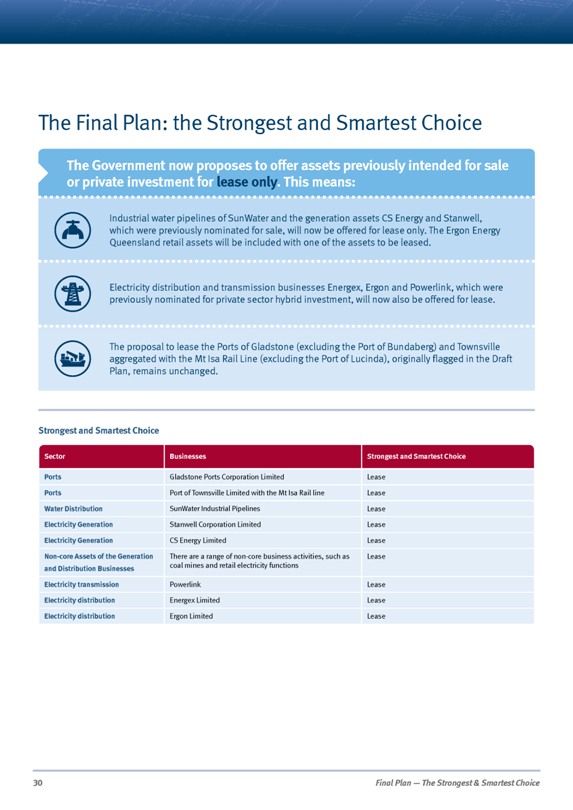
The Final Plan: the Strongest and Smartest Choice
The Government now proposes to offer assets previously intended for sale or private investment for lease only. This means:
Industrial water pipelines of SunWater and the generation assets CS Energy and Stanwell, which were previously nominated for sale, will now be offered for lease only. The Ergon Energy Queensland retail assets will be included with one of the assets to be leased.
Electricity distribution and transmission businesses Energex, Ergon and Powerlink, which were previously nominated for private sector hybrid investment, will now also be offered for lease.
The proposal to lease the Ports of Gladstone (excluding the Port of Bundaberg) and Townsville aggregated with the Mt Isa Rail Line (excluding the Port of Lucinda), originally flagged in the Draft Plan, remains unchanged.
Strongest and Smartest Choice
Sector Businesses Strongest and Smartest Choice
Ports Gladstone Ports Corporation Limited Lease
Ports Port of Townsville Limited with the Mt Isa Rail line Lease
Water Distribution SunWater Industrial Pipelines Lease
Electricity Generation Stanwell Corporation Limited Lease
Electricity Generation CS Energy Limited Lease
Non-core Assets of the Generation and Distribution Businesses There are a range of non-core business activities, such as coal mines and retail electricity functions Lease
Electricity transmission Powerlink Lease
Electricity distribution Energex Limited Lease
Electricity distribution Ergon Limited Lease
30 Final Plan – The Strongest & Smartest Choice
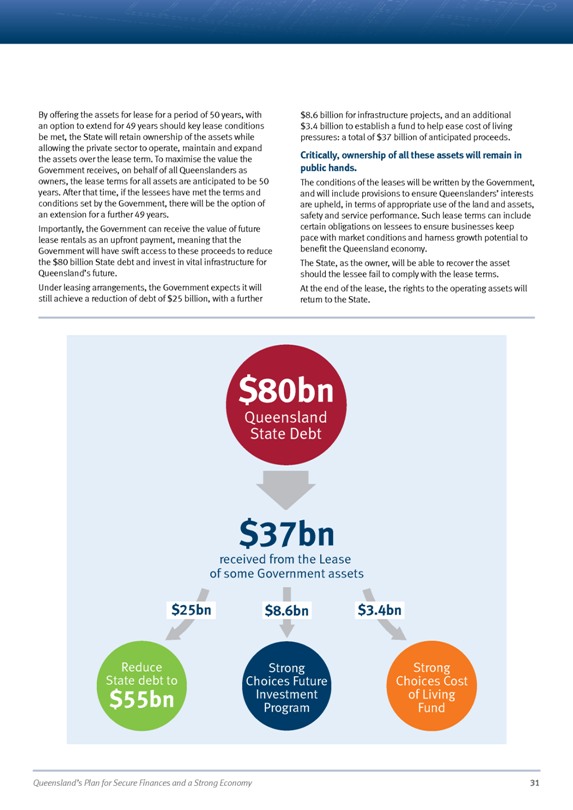
By offering the assets for lease for a period of 50 years, with an option to extend for 49 years should key lease conditions be met, the State will retain ownership of the assets while allowing the private sector to operate, maintain and expand the assets over the lease term. To maximise the value the Government receives, on behalf of all Queenslanders as owners, the lease terms for all assets are anticipated to be 50 years. After that time, if the lessees have met the terms and conditions set by the Government, there will be the option of an extension for a further 49 years.
Importantly, the Government can receive the value of future lease rentals as an upfront payment, meaning that the Government will have swift access to these proceeds to reduce the $80 billion State debt and invest in vital infrastructure for Queensland’s future.
Under leasing arrangements, the Government expects it will still achieve a reduction of debt of $25 billion, with a further
$8.6 billion for infrastructure projects, and an additional $3.4 billion to establish a fund to help ease cost of living pressures: a total of $37 billion of anticipated proceeds.
Critically, ownership of all these assets will remain in public hands.
The conditions of the leases will be written by the Government, and will include provisions to ensure Queenslanders’ interests are upheld, in terms of appropriate use of the land and assets, safety and service performance. Such lease terms can include certain obligations on lessees to ensure businesses keep pace with market conditions and harness growth potential to benefit the Queensland economy.
The State, as the owner, will be able to recover the asset should the lessee fail to comply with the lease terms.
At the end of the lease, the rights to the operating assets will return to the State.
$80bn
Queensland State Debt
$37bn
received from the Lease of some Government assets
$25bn $8.6bn $3.4bn
Reduce State debt to $55bn Strong Choices Future Investment Program Strong Choices Cost of Living Fund
Queensland’s Plan for Secure Finances and a Strong Economy 31
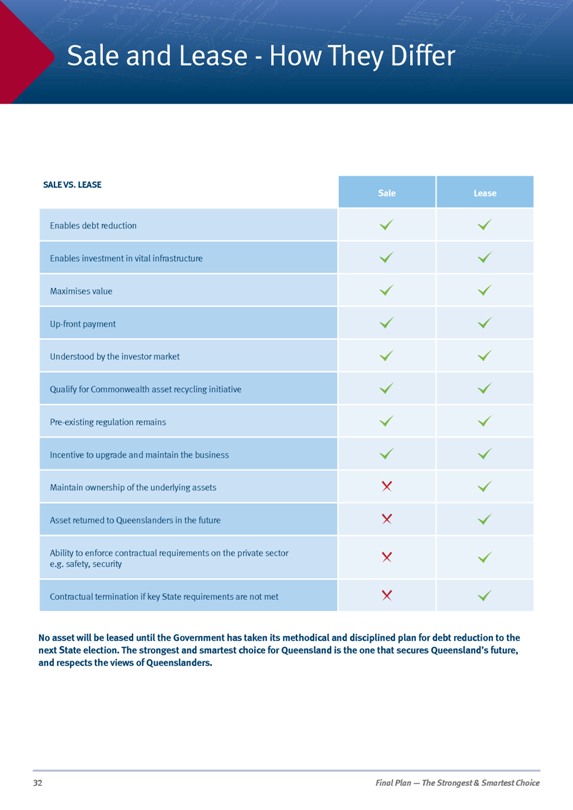
Sale and Lease - How They Differ
SALE VS. LEASE
Sale
Lease
Enables debt reduction
Enables investment in vital infrastructure
Maximises value
Up-front payment
Understood by the investor market
Qualify for Commonwealth asset recycling initiative
Pre-existing regulation remains
Incentive to upgrade and maintain the business
Maintain ownership of the underlying assets
Asset returned to Queenslanders in the future
Ability to enforce contractual requirements on the private sector e.g. safety, security
Contractual termination if key State requirements are not met
No asset will be leased until the Government has taken its methodical and disciplined plan for debt reduction to the next State election. The strongest and smartest choice for Queensland is the one that secures Queensland’s future, and respects the views of Queenslanders.
32 Final Plan – The Strongest & Smartest Choice
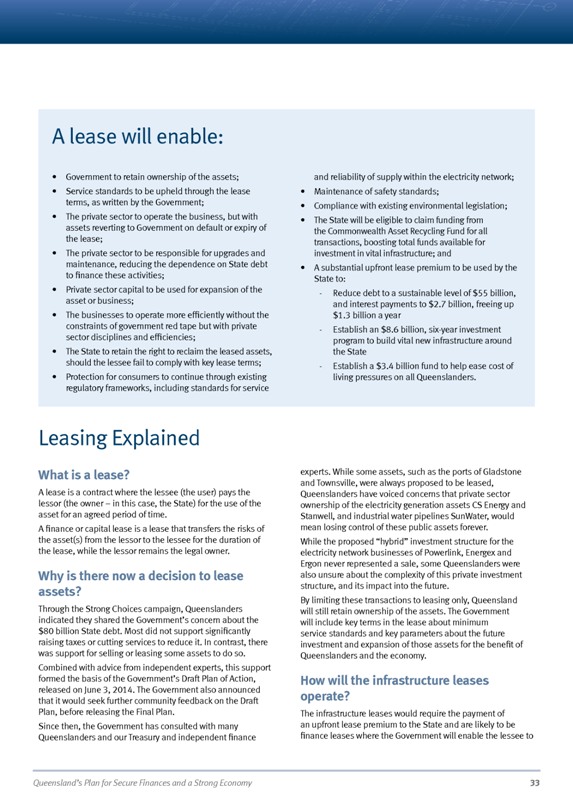
A lease will enable:
Government to retain ownership of the assets;
Service standards to be upheld through the lease terms, as written by the Government;
The private sector to operate the business, but with assets reverting to Government on default or expiry of the lease;
The private sector to be responsible for upgrades and maintenance, reducing the dependence on State debt to finance these activities;
Private sector capital to be used for expansion of the asset or business;
The businesses to operate more efficiently without the constraints of government red tape but with private sector disciplines and efficiencies;
The State to retain the right to reclaim the leased assets, should the lessee fail to comply with key lease terms;
Protection for consumers to continue through existing regulatory frameworks, including standards for service and reliability of supply within the electricity network;
Maintenance of safety standards;
Compliance with existing environmental legislation;
The State will be eligible to claim funding from the Commonwealth Asset Recycling Fund for all transactions, boosting total funds available for investment in vital infrastructure; and
A substantial upfront lease premium to be used by the State to:
- Reduce debt to a sustainable level of $55 billion, and interest payments to $2.7 billion, freeing up $1.3 billion a year
- Establish an $8.6 billion, six-year investment program to build vital new infrastructure around the State
- Establish a $3.4 billion fund to help ease cost of living pressures on all Queenslanders.
Leasing Explained
What is a lease?
A lease is a contract where the lessee (the user) pays the lessor (the owner - in this case, the State) for the use of the asset for an agreed period of time.
A finance or capital lease is a lease that transfers the risks of the asset(s) from the lessor to the lessee for the duration of the lease, while the lessor remains the legal owner.
Why is there now a decision to lease assets?
Through the Strong Choices campaign, Queenslanders indicated they shared the Government’s concern about the $80 billion State debt. Most did not support significantly raising taxes or cutting services to reduce it. In contrast, there was support for selling or leasing some assets to do so.
Combined with advice from independent experts, this support formed the basis of the Government’s Draft Plan of Action, released on June 3, 2014. The Government also announced that it would seek further community feedback on the Draft Plan, before releasing the Final Plan.
Since then, the Government has consulted with many Queenslanders and our Treasury and independent finance experts. While some assets, such as the ports of Gladstone and Townsville, were always proposed to be leased, Queenslanders have voiced concerns that private sector ownership of the electricity generation assets CS Energy and Stanwell, and industrial water pipelines SunWater, would mean losing control of these public assets forever.
While the proposed “hybrid” investment structure for the electricity network businesses of Powerlink, Energex and Ergon never represented a sale, some Queenslanders were also unsure about the complexity of this private investment structure, and its impact into the future.
By limiting these transactions to leasing only, Queensland will still retain ownership of the assets. The Government will include key terms in the lease about minimum service standards and key parameters about the future investment and expansion of those assets for the benefit of Queenslanders and the economy.
How will the infrastructure leases operate?
The infrastructure leases would require the payment of an upfront lease premium to the State and are likely to be finance leases where the Government will enable the lessee to
Queensland’s Plan for Secure Finances and a Strong Economy 33
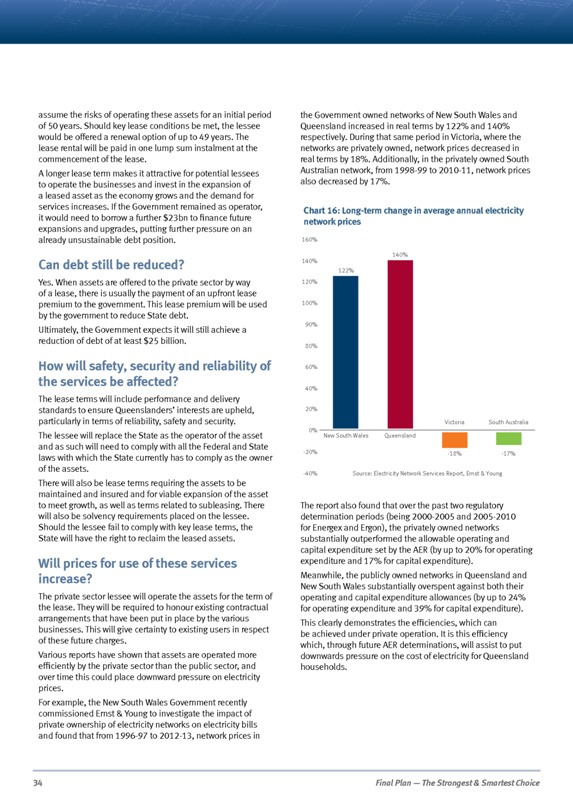
assume the risks of operating these assets for an initial period of 50 years. Should key lease conditions be met, the lessee would be offered a renewal option of up to 49 years. The lease rental will be paid in one lump sum instalment at the commencement of the lease.
A longer lease term makes it attractive for potential lessees to operate the businesses and invest in the expansion of a leased asset as the economy grows and the demand for services increases. If the Government remained as operator, it would need to borrow a further $23bn to finance future expansions and upgrades, putting further pressure on an already unsustainable debt position.
Can debt still be reduced?
Yes. When assets are offered to the private sector by way of a lease, there is usually the payment of an upfront lease premium to the government. This lease premium will be used by the government to reduce State debt.
Ultimately, the Government expects it will still achieve a reduction of debt of at least $25 billion.
How will safety, security and reliability of the services be affected?
The lease terms will include performance and delivery standards to ensure Queenslanders’ interests are upheld, particularly in terms of reliability, safety and security.
The lessee will replace the State as the operator of the asset and as such will need to comply with all the Federal and State laws with which the State currently has to comply as the owner of the assets.
There will also be lease terms requiring the assets to be maintained and insured and for viable expansion of the asset to meet growth, as well as terms related to subleasing. There will also be solvency requirements placed on the lessee. Should the lessee fail to comply with key lease terms, the State will have the right to reclaim the leased assets.
Will prices for use of these services increase?
The private sector lessee will operate the assets for the term of the lease. They will be required to honour existing contractual arrangements that have been put in place by the various businesses. This will give certainty to existing users in respect of these future charges.
Various reports have shown that assets are operated more efficiently by the private sector than the public sector, and over time this could place downward pressure on electricity prices.
For example, the New South Wales Government recently commissioned Ernst & Young to investigate the impact of private ownership of electricity networks on electricity bills and found that from 1996-97 to 2012-13, network prices in
the Government owned networks of New South Wales and Queensland increased in real terms by 122% and 140% respectively. During that same period in Victoria, where the networks are privately owned, network prices decreased in real terms by 18%. Additionally, in the privately owned South Australian network, from 1998-99 to 2010-11, network prices also decreased by 17%.
Chart 16: Long-term change in average annual electricity
network prices
160%
140%
140%
122%
120%
100%
90%
80%
60%
40%
20%
0%
Victoria
South Australia
New South Wales
Queensland
-20%
-18%
-17%
-40%
Source: Electricity Network Services Report, Ernst & Young
The report also found that over the past two regulatory determination periods (being 2000-2005 and 2005-2010 for Energex and Ergon), the privately owned networks substantially outperformed the allowable operating and capital expenditure set by the AER (by up to 20% for operating expenditure and 17% for capital expenditure).
Meanwhile, the publicly owned networks in Queensland and New South Wales substantially overspent against both their operating and capital expenditure allowances (by up to 24% for operating expenditure and 39% for capital expenditure).
This clearly demonstrates the efficiencies, which can be achieved under private operation. It is this efficiency which, through future AER determinations, will assist to put downwards pressure on the cost of electricity for Queensland households.
34 Final Plan – The Strongest & Smartest Choice
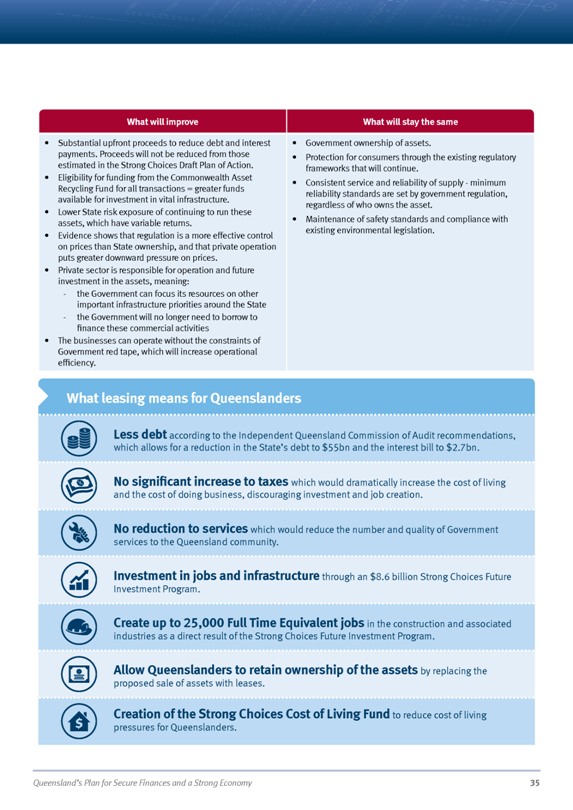
What will improve
Substantial upfront proceeds to reduce debt and interest payments. Proceeds will not be reduced from those estimated in the Strong Choices Draft Plan of Action.
Eligibility for funding from the Commonwealth Asset Recycling Fund for all transactions = greater funds available for investment in vital infrastructure.
Lower State risk exposure of continuing to run these assets, which have variable returns.
Evidence shows that regulation is a more effective control on prices than State ownership, and that private operation puts greater downward pressure on prices.
Private sector is responsible for operation and future investment in the assets, meaning:
- the Government can focus its resources on other important infrastructure priorities around the State
- the Government will no longer need to borrow to finance these commercial activities
The businesses can operate without the constraints of Government red tape, which will increase operational efficiency.
What will stay the same
Government ownership of assets.
Protection for consumers through the existing regulatory frameworks that will continue.
Consistent service and reliability of supply - minimum reliability standards are set by government regulation, regardless of who owns the asset.
Maintenance of safety standards and compliance with existing environmental legislation.
What leasing means for Queenslanders
Less debt according to the Independent Queensland Commission of Audit recommendations, which allows for a reduction in the State’s debt to $55bn and the interest bill to $2.7bn.
No significant increase to taxes which would dramatically increase the cost of living and the cost of doing business, discouraging investment and job creation.
No reduction to services which would reduce the number and quality of Government services to the Queensland community.
Investment in jobs and infrastructure through an $8.6 billion Strong Choices Future Investment Program.
Create up to 25,000 Full Time Equivalent jobs in the construction and associated
industries as a direct result of the Strong Choices Future Investment Program.
Allow Queenslanders to retain ownership of the assets by replacing the
proposed sale of assets with leases.
Creation of the Strong Choices Cost of Living Fund to reduce cost of living
pressures for Queenslanders.
Queensland’s Plan for Secure Finances and a Strong Economy 35
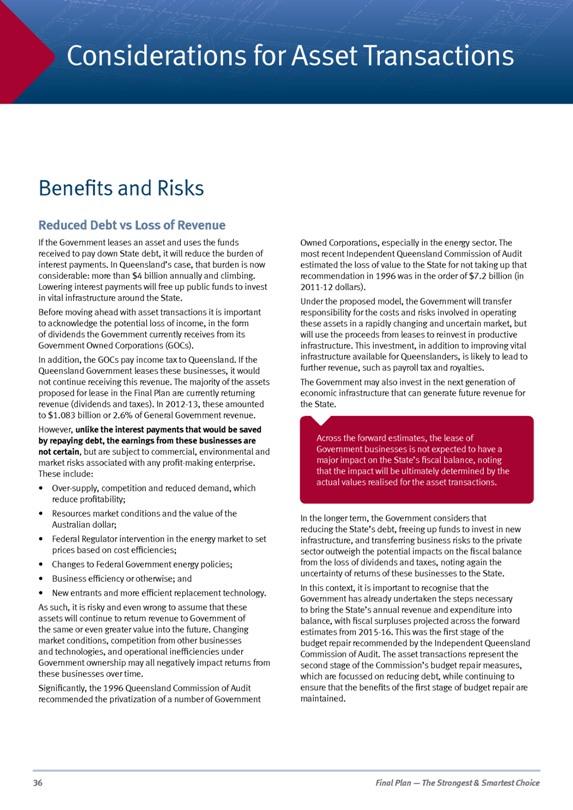
Considerations for Asset Transactions
Benefits and Risks
Reduced Debt vs Loss of Revenue
If the Government leases an asset and uses the funds received to pay down State debt, it will reduce the burden of interest payments. In Queensland’s case, that burden is now considerable: more than $4 billion annually and climbing. Lowering interest payments will free up public funds to invest in vital infrastructure around the State.
Before moving ahead with asset transactions it is important to acknowledge the potential loss of income, in the form of dividends the Government currently receives from its Government Owned Corporations (GOCs).
In addition, the GOCs pay income tax to Queensland. If the Queensland Government leases these businesses, it would not continue receiving this revenue. The majority of the assets proposed for lease in the Final Plan are currently returning revenue (dividends and taxes). In 2012-13, these amounted to $1.083 billion or 2.6% of General Government revenue.
However, unlike the interest payments that would be saved by repaying debt, the earnings from these businesses are not certain, but are subject to commercial, environmental and market risks associated with any profit-making enterprise. These include:
Over-supply, competition and reduced demand, which reduce profitability;
Resources market conditions and the value of the Australian dollar;
Federal Regulator intervention in the energy market to set prices based on cost efficiencies;
Changes to Federal Government energy policies;
Business efficiency or otherwise; and
New entrants and more efficient replacement technology.
As such, it is risky and even wrong to assume that these assets will continue to return revenue to Government of the same or even greater value into the future. Changing market conditions, competition from other businesses and technologies, and operational inefficiencies under Government ownership may all negatively impact returns from these businesses over time.
Significantly, the 1996 Queensland Commission of Audit recommended the privatization of a number of Government
Owned Corporations, especially in the energy sector. The most recent Independent Queensland Commission of Audit estimated the loss of value to the State for not taking up that recommendation in 1996 was in the order of $7.2 billion (in 2011-12 dollars).
Under the proposed model, the Government will transfer responsibility for the costs and risks involved in operating these assets in a rapidly changing and uncertain market, but will use the proceeds from leases to reinvest in productive infrastructure. This investment, in addition to improving vital infrastructure available for Queenslanders, is likely to lead to further revenue, such as payroll tax and royalties.
The Government may also invest in the next generation of economic infrastructure that can generate future revenue for the State.
In the longer term, the Government considers that reducing the State’s debt, freeing up funds to invest in new infrastructure, and transferring business risks to the private sector outweigh the potential impacts on the fiscal balance from the loss of dividends and taxes, noting again the uncertainty of returns of these businesses to the State.
In this context, it is important to recognise that the Government has already undertaken the steps necessary to bring the State’s annual revenue and expenditure into balance, with fiscal surpluses projected across the forward estimates from 2015-16. This was the first stage of the budget repair recommended by the Independent Queensland Commission of Audit. The asset transactions represent the second stage of the Commission’s budget repair measures, which are focussed on reducing debt, while continuing to ensure that the benefits of the first stage of budget repair are maintained.
36 Final Plan – The Strongest & Smartest Choice

Federal Government Incentives
In May 2014, the Commonwealth Government announced an incentive within the Federal Budget to encourage the States to recycle existing assets through majority sale or lease into productive economic infrastructure. The Asset Recycling Initiative is a $5 Billion initiative allocating funds to the States on a first come first served basis for new productive infrastructure investment financed from asset sales or leases. The funds are available to the States for projects between 1 July 2014 and 30 June 2019 and are calculated as 15% of the value of the asset recycled, less any debt repaid with transaction proceeds. This is an opportunity for Queensland to increase the State’s revenue, conditional on the utilisation of the proceeds. Queensland could receive more than $1bn from this initiative.
Jobs
The nature and extent of employment in a leased asset depends on how efficiently the business was being run by government and the future growth potential of the business. There are likely to be changes in the composition of the workforce as a result of the differing demands and expectations of the government and private sector.
For example, the Government monitors and requires ongoing reporting of certain types of expenditure like entertainment and travel, and issues more focused on the operation of government. A private-sector lessee will have a different focus and may require employees with different skills.
Further investment and growth in leased businesses can create new employment opportunities.
The Strong Choices Future Investment Program is expected to directly support approximately 25,000 full time equivalent (FTE) jobs in the Queensland construction and supporting industries.
Commonwealth Serum Laboratories (CSL Limited), for example, obtained private investment through an initial public offering in 1994. At that time, CSL Limited had 1300 employees in Australia, had sales of $170 million and paid $4 million in tax. Today it has over 11,000 employees in Australia and around the world, sales of almost $5 billion and pays $300 million in tax.
Pricing/competition
Government-owned businesses including those in the electricity, port and water pipeline sectors are subject to the same competition and pricing arrangements as their private sector counterparts under State and Federal legislation.
Should they be leased, they will be subject to the same pricing constraints or regulatory structures. For example:
Wholesale electricity prices are set by the Australian Energy Market Operator (AEMO) every thirty minutes, based on competitive bids from generation plants, both public and private.
All electricity network businesses, whether publicly or privately owned, are subject to the same detailed revenue and price regulation by the Australian Energy Regulator (AER). Every five years, the AER sets “allowed revenues” and reviews their annual pricing proposals for compliance with the National Electricity Rules.
The Queensland Competition Authority monitor electricity prices charged by electricity retailers, helping consumers to better understand and take advantage of the choices on offer.
Water prices are negotiated commercially before the pipeline is built and usually set for the life of the contract.
Ports negotiate long term agreements (usually about 10 years) with their customers who are typically large resource companies that provide pricing certainty.
Any natural monopolies can be subject to regulation if there are concerns that monopoly power is being abused.
The Queensland Government has specific arrangements for electricity pricing in rural and regional Queensland. The cost of electricity supply to South East Queensland is lower than the cost of supply in regional Queensland, because electricity must be distributed across much greater distances to reach customers in regional Queensland. The Government’s uniform tariff policy (UTP) ensures all Queensland non-market electricity customers of a similar type pay the same price for electricity, regardless of where they live. As these prices do not reflect the full cost of electricity supply for most remote and regional Queenslanders, the Government provides subsidy funding to Ergon Energy Queensland. In 2014-15 this subsidy payment is expected to total in excess of $650 million.
The Government proposes to open the south east Queensland electricity market to competition to encourage electricity price competition between retailers for the benefit of Queenslanders.
The Government’s policy that regional Queenslanders should pay a price for electricity which is on a par with that paid by the residents of South East Queensland will not change as a result of the introduction of price competition.
This will require changes to the EEQ subsidy arrangements, so that customers can access the benefit of the subsidy whether EEQ or a privately-owned retailer supplies them. Importantly the subsidy will remain.
Queensland’s Plan for Secure Finances and a Strong Economy 37
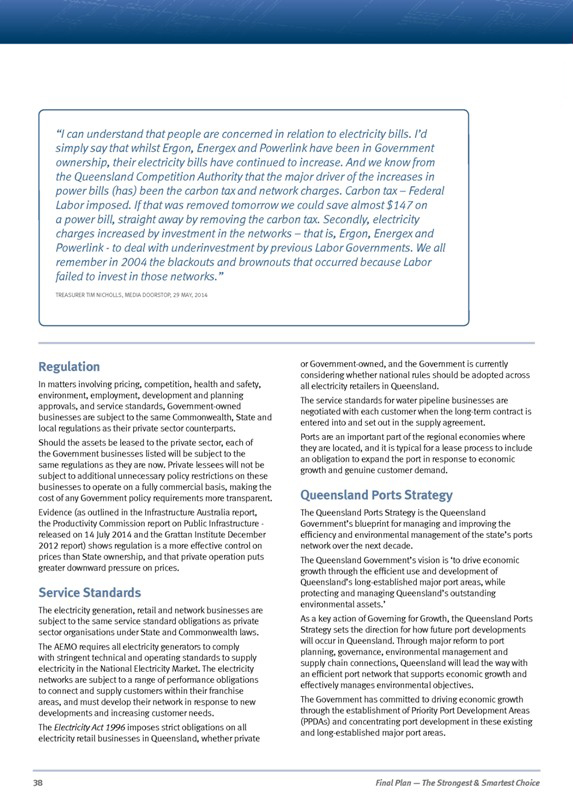
“I can understand that people are concerned in relation to electricity bills. I’d simply say that whilst Ergon, Energex and Powerlink have been in Government ownership, their electricity bills have continued to increase. And we know from the Queensland Competition Authority that the major driver of the increases in power bills (has) been the carbon tax and network charges. Carbon tax – Federal Labor imposed. If that was removed tomorrow we could save almost $147 on a power bill, straight away by removing the carbon tax. Secondly, electricity charges increased by investment in the networks – that is, Ergon, Energex and Powerlink – to deal with underinvestment by previous Labor Governments. We all remember in 2004 the blackouts and brownouts that occurred because Labor failed to invest in those networks.”
TREASURER TIM NICHOLLS, MEDIA DOORSTOP, 29 MAY, 2014
Regulation
In matters involving pricing, competition, health and safety, environment, employment, development and planning approvals, and service standards, Government-owned businesses are subject to the same Commonwealth, State and local regulations as their private sector counterparts.
Should the assets be leased to the private sector, each of the Government businesses listed will be subject to the same regulations as they are now. Private lessees will not be subject to additional unnecessary policy restrictions on these businesses to operate on a fully commercial basis, making the cost of any Government policy requirements more transparent.
Evidence (as outlined in the Infrastructure Australia report, the Productivity Commission report on Public Infrastructure - released on 14 July 2014 and the Grattan Institute December 2012 report) shows regulation is a more effective control on prices than State ownership, and that private operation puts greater downward pressure on prices.
Service Standards
The electricity generation, retail and network businesses are subject to the same service standard obligations as private sector organisations under State and Commonwealth laws.
The AEMO requires all electricity generators to comply with stringent technical and operating standards to supply electricity in the National Electricity Market. The electricity networks are subject to a range of performance obligations to connect and supply customers within their franchise areas, and must develop their network in response to new developments and increasing customer needs.
The Electricity Act 1996 imposes strict obligations on all electricity retail businesses in Queensland, whether private
or Government-owned, and the Government is currently considering whether national rules should be adopted across all electricity retailers in Queensland.
The service standards for water pipeline businesses are negotiated with each customer when the long-term contract is entered into and set out in the supply agreement.
Ports are an important part of the regional economies where they are located, and it is typical for a lease process to include an obligation to expand the port in response to economic growth and genuine customer demand.
Queensland Ports Strategy
The Queensland Ports Strategy is the Queensland Government’s blueprint for managing and improving the efficiency and environmental management of the state’s ports network over the next decade.
The Queensland Government’s vision is ‘to drive economic growth through the efficient use and development of Queensland’s long-established major port areas, while protecting and managing Queensland’s outstanding environmental assets.’
As a key action of Governing for Growth, the Queensland Ports Strategy sets the direction for how future port developments will occur in Queensland. Through major reform to port planning, governance, environmental management and supply chain connections, Queensland will lead the way with an efficient port network that supports economic growth and effectively manages environmental objectives.
The Government has committed to driving economic growth through the establishment of Priority Port Development Areas (PPDAs) and concentrating port development in these existing and long-established major port areas.
38 Final Plan – The Strongest & Smartest Choice
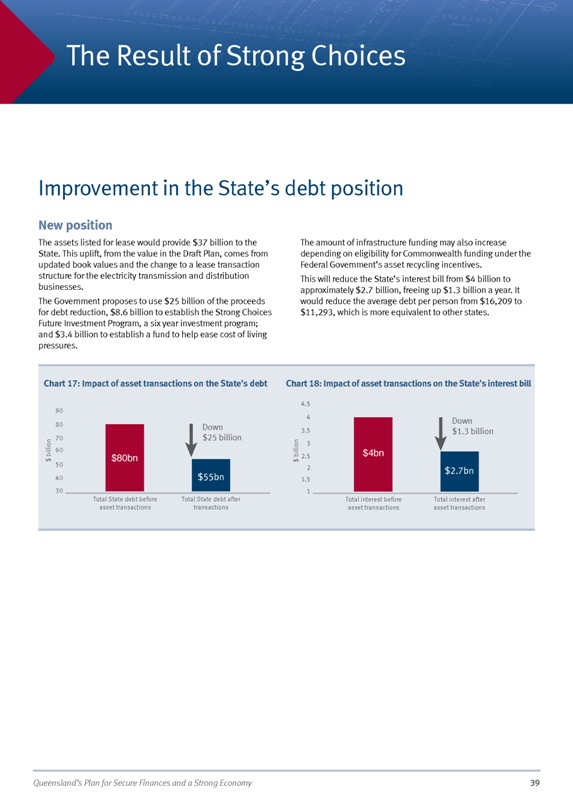
The Result of Strong Choices
Improvement in the State’s debt position
New position
The assets listed for lease would provide $37 billion to the State. This uplift, from the value in the Draft Plan, comes from updated book values and the change to a lease transaction structure for the electricity transmission and distribution businesses.
The Government proposes to use $25 billion of the proceeds for debt reduction, $8.6 billion to establish the Strong Choices Future Investment Program, a six year investment program; and $3.4 billion to establish a fund to help ease cost of living pressures.
The amount of infrastructure funding may also increase depending on eligibility for Commonwealth funding under the Federal Government’s asset recycling incentives.
This will reduce the State’s interest bill from $4 billion to approximately $2.7 billion, freeing up $1.3 billion a year. It would reduce the average debt per person from $16,209 to $11,293, which is more equivalent to other states.
Chart 17: Impact of asset transactions on the State’s debt
$ billion
90
80
70
60
50
40
30
$80bn
Down $25 billion
$55bn
Total State debt before asset transactions
Total State debt after transactions
Chart 18: Impact of asset transactions on the State’s interest bill
$ billion
4.5
4
3.5
3
2.5
2
1.5
1
$4bn
Down $1.3 billion
$2.7bn
Total interest before asset transactions
Total interest after asset transactions
Queensland’s Plan for Secure Finances and a Strong Economy 39
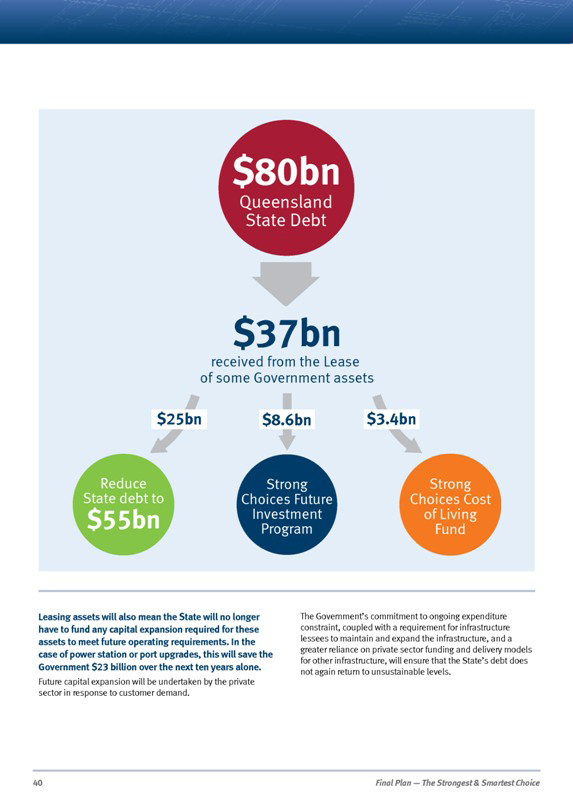
$80bn
Queensland State Debt
$37bn
received from the Lease of some Government assets
$25bn
Reduce State debt to $ 55 bn
$8.6bn
Strong Choices Future Investment Program
$3.4bn
Strong Choices Cost of Living Fund
Leasing assets will also mean the State will no longer have to fund any capital expansion required for these assets to meet future operating requirements. In the case of power station or port upgrades, this will save the Government $23 billion over the next ten years alone.
Future capital expansion will be undertaken by the private sector in response to customer demand.
The Government’s commitment to ongoing expenditure constraint, coupled with a requirement for infrastructure lessees to maintain and expand the infrastructure, and a greater reliance on private sector funding and delivery models for other infrastructure, will ensure that the State’s debt does not again return to unsustainable levels.
40 Final Plan – The Strongest & Smartest Choice
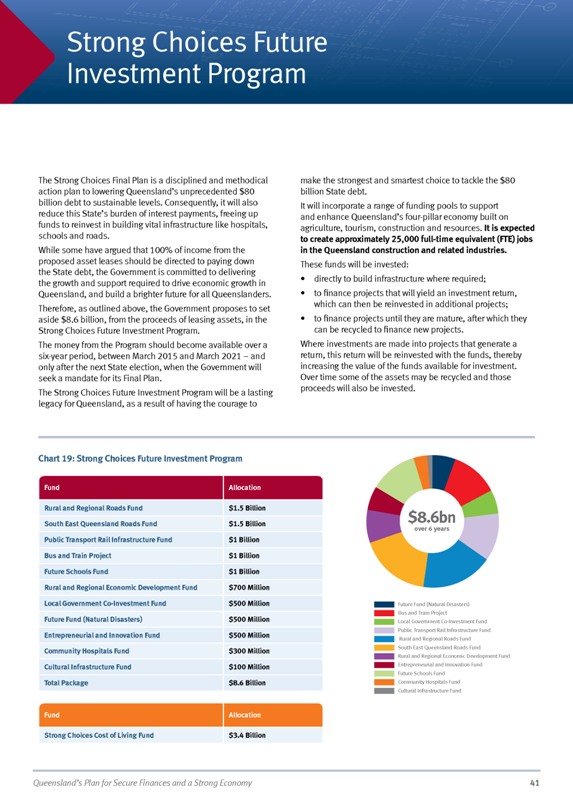
Strong Choices Future Investment Program
The Strong Choices Final Plan is a disciplined and methodical action plan to lowering Queensland’s unprecedented $80 billion debt to sustainable levels. Consequently, it will also reduce this State’s burden of interest payments, freeing up funds to reinvest in building vital infrastructure like hospitals, schools and roads.
While some have argued that 100% of income from the proposed asset leases should be directed to paying down the State debt, the Government is committed to delivering the growth and support required to drive economic growth in Queensland, and build a brighter future for all Queenslanders.
Therefore, as outlined above, the Government proposes to set aside $8.6 billion, from the proceeds of leasing assets, in the Strong Choices Future Investment Program.
The money from the Program should become available over a six-year period, between March 2015 and March 2021 - and only after the next State election, when the Government will seek a mandate for its Final Plan.
The Strong Choices Future Investment Program will be a lasting legacy for Queensland, as a result of having the courage to
make the strongest and smartest choice to tackle the $80 billion State debt.
It will incorporate a range of funding pools to support and enhance Queensland’s four-pillar economy built on agriculture, tourism, construction and resources. It is expected to create approximately 25,000 full-time equivalent (FTE) jobs in the Queensland construction and related industries.
These funds will be invested:
directly to build infrastructure where required;
to finance projects that will yield an investment return, which can then be reinvested in additional projects;
to finance projects until they are mature, after which they can be recycled to finance new projects.
Where investments are made into projects that generate a return, this return will be reinvested with the funds, thereby increasing the value of the funds available for investment.
Over time some of the assets may be recycled and those proceeds will also be invested.
Chart 19: Strong Choices Future Investment Program
Fund Allocation
Rural and Regional Roads Fund $1.5 Billion
South East Queensland Roads Fund $1.5 Billion
Public Transport Rail Infrastructure Fund $1 Billion
Bus and Train Project $1 Billion
Future Schools Fund $1 Billion
Rural and Regional Economic Development Fund $700 Million
Local Government Co-Investment Fund $500 Million
Future Fund (Natural Disasters) $500 Million
Entrepreneurial and Innovation Fund $500 Million
Community Hospitals Fund $300 Million
Cultural Infrastructure Fund $100 Million
Total Package $8.6 Billion
Fund Allocation
Strong Choices Cost of Living Fund $3.4 Billion
$8.6bn
over 6 years
Future Fund (Natural Disasters)
Bus and Train Project
Local Government Co-Investment Fund
Public Transport Rail Infrastructure Fund
Rural and Regional Roads Fund
South East Queensland Roads Fund
Rural and Regional Economic Development Fund
Entrepreneurial and Innovation Fund
Future Schools Fund
Community Hospitals Fund
Cultural Infrastructure Fund
Queensland’s Plan for Secure Finances and a Strong Economy 41
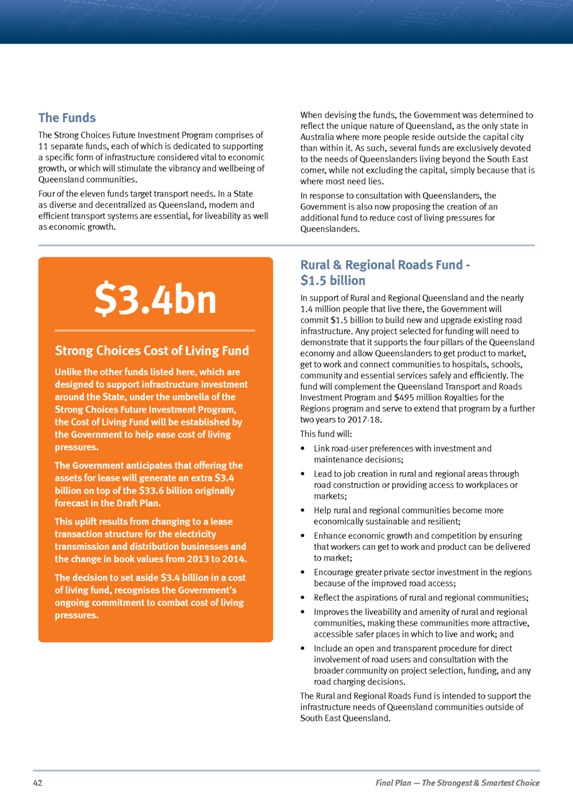
The Funds
The Strong Choices Future Investment Program comprises of 11 separate funds, each of which is dedicated to supporting a specific form of infrastructure considered vital to economic growth, or which will stimulate the vibrancy and wellbeing of Queensland communities.
Four of the eleven funds target transport needs. In a State as diverse and decentralized as Queensland, modern and efficient transport systems are essential, for liveability as well as economic growth.
When devising the funds, the Government was determined to reflect the unique nature of Queensland, as the only state in Australia where more people reside outside the capital city than within it. As such, several funds are exclusively devoted to the needs of Queenslanders living beyond the South East corner, while not excluding the capital, simply because that is where most need lies.
In response to consultation with Queenslanders, the Government is also now proposing the creation of an additional fund to reduce cost of living pressures for Queenslanders.
$3.4bn
Strong Choices Cost of Living Fund
Unlike the other funds listed here, which are designed to support infrastructure investment around the State, under the umbrella of the Strong Choices Future Investment Program, the Cost of Living Fund will be established by the Government to help ease cost of living pressures.
The Government anticipates that offering the assets for lease will generate an extra $3.4 billion on top of the $33.6 billion originally forecast in the Draft Plan.
This uplift results from changing to a lease transaction structure for the electricity transmission and distribution businesses and the change in book values from 2013 to 2014.
The decision to set aside $3.4 billion in a cost of living fund, recognises the Government’s ongoing commitment to combat cost of living pressures.
Rural & Regional Roads Fund - $1.5 billion
In support of Rural and Regional Queensland and the nearly 1.4 million people that live there, the Government will commit $1.5 billion to build new and upgrade existing road infrastructure. Any project selected for funding will need to demonstrate that it supports the four pillars of the Queensland economy and allow Queenslanders to get product to market, get to work and connect communities to hospitals, schools, community and essential services safely and efficiently. The fund will complement the Queensland Transport and Roads Investment Program and $495 million Royalties for the Regions program and serve to extend that program by a further two years to 2017-18.
This fund will:
Link road-user preferences with investment and maintenance decisions;
Lead to job creation in rural and regional areas through road construction or providing access to workplaces or markets;
Help rural and regional communities become more economically sustainable and resilient;
Enhance economic growth and competition by ensuring that workers can get to work and product can be delivered to market;
Encourage greater private sector investment in the regions because of the improved road access;
Reflect the aspirations of rural and regional communities;
Improves the liveability and amenity of rural and regional communities, making these communities more attractive, accessible safer places in which to live and work; and
Include an open and transparent procedure for direct involvement of road users and consultation with the broader community on project selection, funding, and any road charging decisions.
The Rural and Regional Roads Fund is intended to support the infrastructure needs of Queensland communities outside of South East Queensland.
42 Final Plan – The Strongest & Smartest Choice
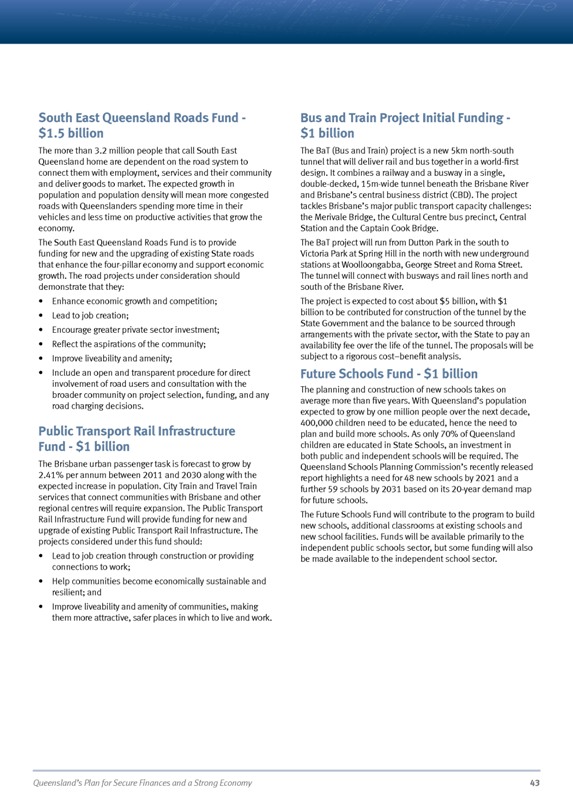
South East Queensland Roads Fund - $1.5 billion
The more than 3.2 million people that call South East Queensland home are dependent on the road system to connect them with employment, services and their community and deliver goods to market. The expected growth in population and population density will mean more congested roads with Queenslanders spending more time in their vehicles and less time on productive activities that grow the economy.
The South East Queensland Roads Fund is to provide funding for new and the upgrading of existing State roads that enhance the four-pillar economy and support economic growth. The road projects under consideration should demonstrate that they:
Enhance economic growth and competition;
Lead to job creation;
Encourage greater private sector investment;
Reflect the aspirations of the community;
Improve liveability and amenity;
Include an open and transparent procedure for direct involvement of road users and consultation with the broader community on project selection, funding, and any road charging decisions.
Public Transport Rail Infrastructure Fund - $1 billion
The Brisbane urban passenger task is forecast to grow by 2.41% per annum between 2011 and 2030 along with the expected increase in population. City Train and Travel Train services that connect communities with Brisbane and other regional centres will require expansion. The Public Transport Rail Infrastructure Fund will provide funding for new and upgrade of existing Public Transport Rail Infrastructure. The projects considered under this fund should:
Lead to job creation through construction or providing connections to work;
Help communities become economically sustainable and resilient; and
Improve liveability and amenity of communities, making them more attractive, safer places in which to live and work.
Bus and Train Project Initial Funding - $1 billion
The BaT (Bus and Train) project is a new 5km north-south tunnel that will deliver rail and bus together in a world-first design. It combines a railway and a busway in a single, double-decked, 15m-wide tunnel beneath the Brisbane River and Brisbane’s central business district (CBD). The project tackles Brisbane’s major public transport capacity challenges: the Merivale Bridge, the Cultural Centre bus precinct, Central Station and the Captain Cook Bridge.
The BaT project will run from Dutton Park in the south to Victoria Park at Spring Hill in the north with new underground stations at Woolloongabba, George Street and Roma Street. The tunnel will connect with busways and rail lines north and south of the Brisbane River.
The project is expected to cost about $5 billion, with $1 billion to be contributed for construction of the tunnel by the State Government and the balance to be sourced through arrangements with the private sector, with the State to pay an availability fee over the life of the tunnel. The proposals will be subject to a rigorous cost-benefit analysis.
Future Schools Fund - $1 billion
The planning and construction of new schools takes on average more than five years. With Queensland’s population expected to grow by one million people over the next decade, 400,000 children need to be educated, hence the need to plan and build more schools. As only 70% of Queensland children are educated in State Schools, an investment in both public and independent schools will be required. The Queensland Schools Planning Commission’s recently released report highlights a need for 48 new schools by 2021 and a further 59 schools by 2031 based on its 20-year demand map for future schools.
The Future Schools Fund will contribute to the program to build new schools, additional classrooms at existing schools and new school facilities. Funds will be available primarily to the independent public schools sector, but some funding will also be made available to the independent school sector.
Queensland’s Plan for Secure Finances and a Strong Economy 43
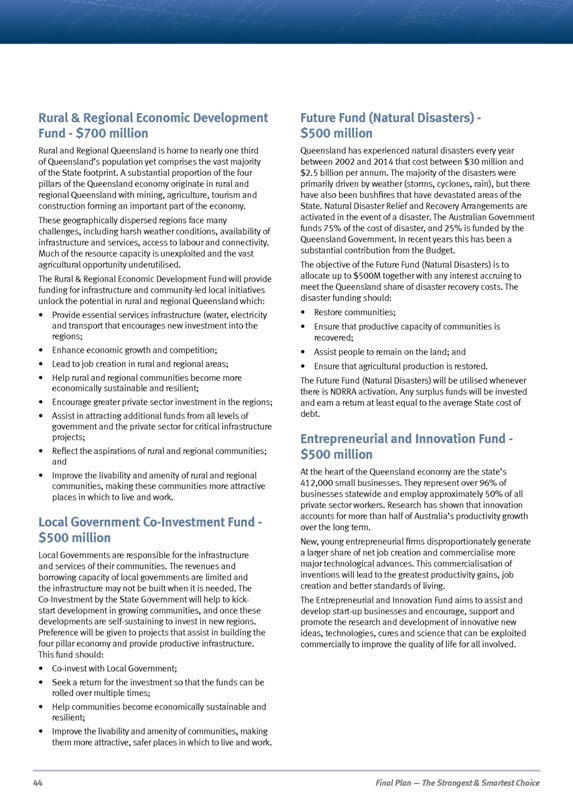
Rural & Regional Economic Development Fund - $700 million
Rural and Regional Queensland is home to nearly one third of Queensland’s population yet comprises the vast majority of the State footprint. A substantial proportion of the four pillars of the Queensland economy originate in rural and regional Queensland with mining, agriculture, tourism and construction forming an important part of the economy.
These geographically dispersed regions face many challenges, including harsh weather conditions, availability of infrastructure and services, access to labour and connectivity. Much of the resource capacity is unexploited and the vast agricultural opportunity underutilised.
The Rural & Regional Economic Development Fund will provide funding for infrastructure and community-led local initiatives unlock the potential in rural and regional Queensland which:
Provide essential services infrastructure (water, electricity and transport that encourages new investment into the regions;
Enhance economic growth and competition;
Lead to job creation in rural and regional areas;
Help rural and regional communities become more economically sustainable and resilient;
Encourage greater private sector investment in the regions;
Assist in attracting additional funds from all levels of government and the private sector for critical infrastructure projects;
Reflect the aspirations of rural and regional communities; and
Improve the livability and amenity of rural and regional communities, making these communities more attractive places in which to live and work.
Local Government Co-Investment Fund - $500 million
Local Governments are responsible for the infrastructure and services of their communities. The revenues and borrowing capacity of local governments are limited and the infrastructure may not be built when it is needed. The Co-Investment by the State Government will help to kick- start development in growing communities, and once these developments are self-sustaining to invest in new regions. Preference will be given to projects that assist in building the four pillar economy and provide productive infrastructure.
This fund should:
Co-invest with Local Government;
Seek a return for the investment so that the funds can be rolled over multiple times;
Help communities become economically sustainable and resilient;
Improve the livability and amenity of communities, making them more attractive, safer places in which to live and work.
Future Fund (Natural Disasters) - $500 million
Queensland has experienced natural disasters every year between 2002 and 2014 that cost between $30 million and $2.5 billion per annum. The majority of the disasters were primarily driven by weather (storms, cyclones, rain), but there have also been bushfires that have devastated areas of the State. Natural Disaster Relief and Recovery Arrangements are activated in the event of a disaster. The Australian Government funds 75% of the cost of disaster, and 25% is funded by the Queensland Government. In recent years this has been a substantial contribution from the Budget.
The objective of the Future Fund (Natural Disasters) is to allocate up to $500M together with any interest accruing to meet the Queensland share of disaster recovery costs. The disaster funding should:
Restore communities;
Ensure that productive capacity of communities is recovered;
Assist people to remain on the land; and
Ensure that agricultural production is restored.
The Future Fund (Natural Disasters) will be utilised whenever there is NDRRA activation. Any surplus funds will be invested and earn a return at least equal to the average State cost of debt.
Entrepreneurial and Innovation Fund - $500 million
At the heart of the Queensland economy are the state’s 412,000 small businesses. They represent over 96% of businesses statewide and employ approximately 50% of all private sector workers. Research has shown that innovation accounts for more than half of Australia’s productivity growth over the long term.
New, young entrepreneurial firms disproportionately generate a larger share of net job creation and commercialise more major technological advances. This commercialisation of inventions will lead to the greatest productivity gains, job creation and better standards of living.
The Entrepreneurial and Innovation Fund aims to assist and develop start-up businesses and encourage, support and promote the research and development of innovative new ideas, technologies, cures and science that can be exploited commercially to improve the quality of life for all involved.
44 Final Plan – The Strongest & Smartest Choice
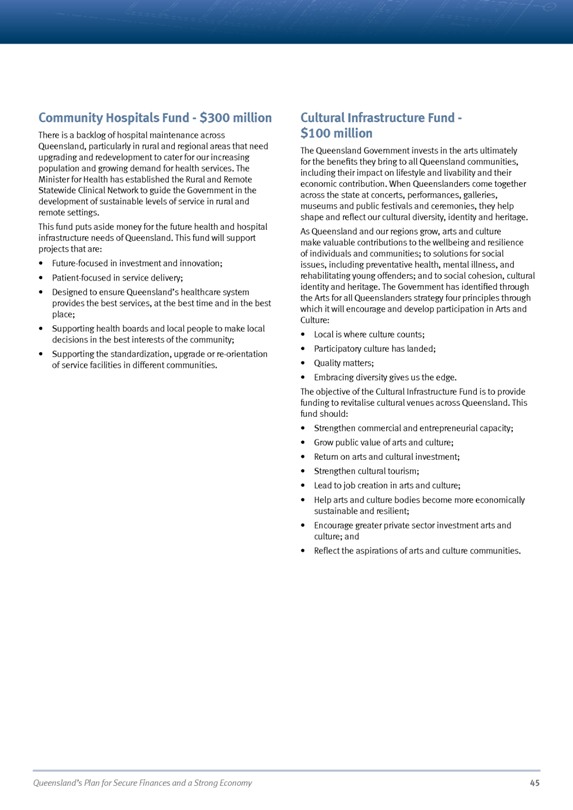
Community Hospitals Fund - $300 million
There is a backlog of hospital maintenance across Queensland, particularly in rural and regional areas that need upgrading and redevelopment to cater for our increasing population and growing demand for health services. The Minister for Health has established the Rural and Remote Statewide Clinical Network to guide the Government in the development of sustainable levels of service in rural and remote settings.
This fund puts aside money for the future health and hospital infrastructure needs of Queensland. This fund will support projects that are:
Future-focused in investment and innovation;
Patient-focused in service delivery;
Designed to ensure Queensland’s healthcare system provides the best services, at the best time and in the best place;
Supporting health boards and local people to make local decisions in the best interests of the community;
Supporting the standardization, upgrade or re-orientation of service facilities in different communities.
Cultural Infrastructure Fund - $100 million
The Queensland Government invests in the arts ultimately for the benefits they bring to all Queensland communities, including their impact on lifestyle and livability and their economic contribution. When Queenslanders come together across the state at concerts, performances, galleries, museums and public festivals and ceremonies, they help shape and reflect our cultural diversity, identity and heritage.
As Queensland and our regions grow, arts and culture make valuable contributions to the wellbeing and resilience of individuals and communities; to solutions for social issues, including preventative health, mental illness, and rehabilitating young offenders; and to social cohesion, cultural identity and heritage. The Government has identified through the Arts for all Queenslanders strategy four principles through which it will encourage and develop participation in Arts and Culture:
Local is where culture counts;
Participatory culture has landed;
Quality matters;
Embracing diversity gives us the edge.
The objective of the Cultural Infrastructure Fund is to provide funding to revitalise cultural venues across Queensland. This fund should:
Strengthen commercial and entrepreneurial capacity;
Grow public value of arts and culture;
Return on arts and cultural investment;
Strengthen cultural tourism;
Lead to job creation in arts and culture;
Help arts and culture bodies become more economically sustainable and resilient;
Encourage greater private sector investment arts and culture; and
Reflect the aspirations of arts and culture communities.
Queensland’s Plan for Secure Finances and a Strong Economy 45
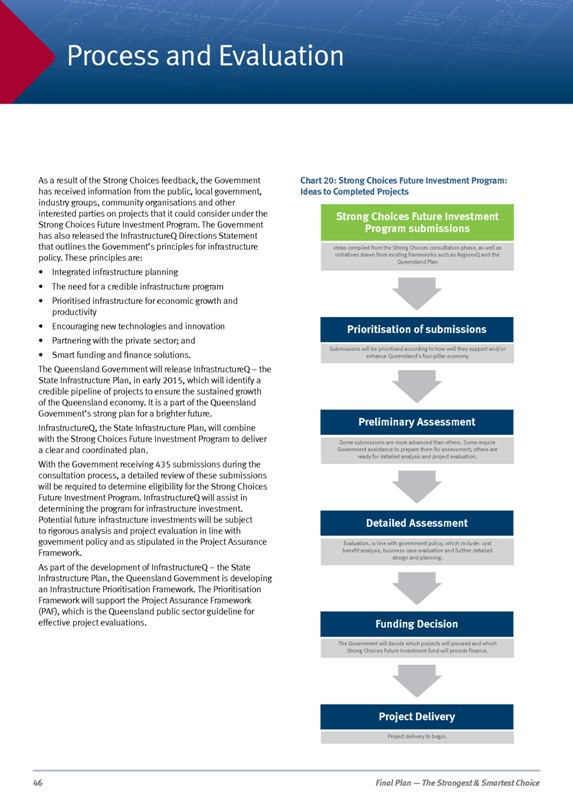
Process and Evaluation
As a result of the Strong Choices feedback, the Government has received information from the public, local government, industry groups, community organisations and other interested parties on projects that it could consider under the Strong Choices Future Investment Program. The Government has also released the InfrastructureQ Directions Statement that outlines the Government’s principles for infrastructure policy. These principles are:
Integrated infrastructure planning
The need for a credible infrastructure program
Prioritised infrastructure for economic growth and productivity
Encouraging new technologies and innovation
Partnering with the private sector; and
Smart funding and finance solutions.
The Queensland Government will release InfrastructureQ - the State Infrastructure Plan, in early 2015, which will identify a credible pipeline of projects to ensure the sustained growth of the Queensland economy. It is a part of the Queensland Government’s strong plan for a brighter future.
InfrastructureQ, the State Infrastructure Plan, will combine with the Strong Choices Future Investment Program to deliver a clear and coordinated plan.
With the Government receiving 435 submissions during the consultation process, a detailed review of these submissions will be required to determine eligibility for the Strong Choices Future Investment Program. InfrastructureQ will assist in determining the program for infrastructure investment. Potential future infrastructure investments will be subject to rigorous analysis and project evaluation in line with government policy and as stipulated in the Project Assurance Framework.
As part of the development of InfrastructureQ - the State Infrastructure Plan, the Queensland Government is developing an Infrastructure Prioritisation Framework. The Prioritisation Framework will support the Project Assurance Framework (PAF), which is the Queensland public sector guideline for effective project evaluations.
Chart 20: Strong Choices Future Investment Program: Ideas to Completed Projects
Strong Choices Future Investment Program submissions
Ideas compiled from the Strong Choices consultation phase, as well as initiatives drawn from existing frameworks such as RegionsQ and the Queensland Plan
Prioritisation of submissions
Submissions will be prioritised according to how well they support and/or enhance Queensland’s four-pillar economy
Preliminary Assessment
Some submissions are more advanced than others. Some require Government assistance to prepare them for assessment; others are ready for detailed analysis and project evaluation.
Detailed Assessment
Evaluation, is line with government policy, which include: cost benefit analysis, business case evaluation and further detailed design and planning.
Funding Decision
The Government will decide which projects will proceed and which Strong Choices Future Investment fund will provide finance.
Project Delivery
Project delivery to begin.
46 Final Plan – The Strongest & Smartest Choice
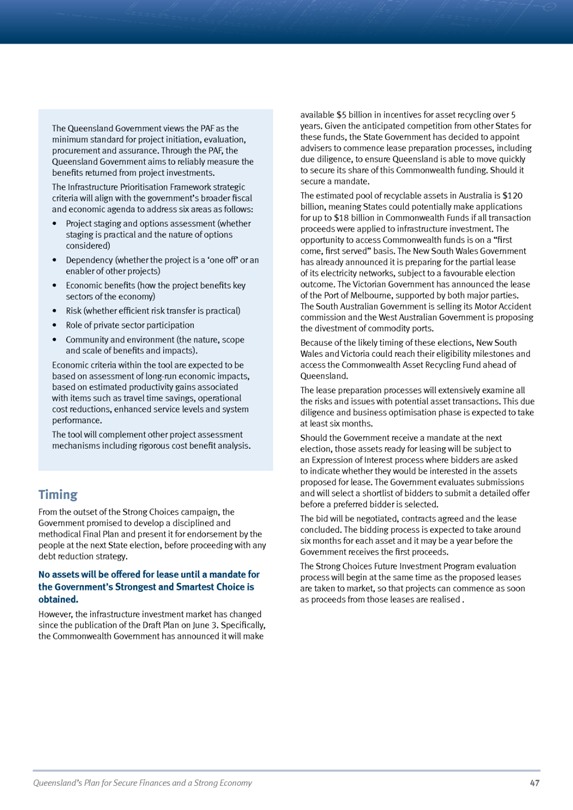
The Queensland Government views the PAF as the minimum standard for project initiation, evaluation, procurement and assurance. Through the PAF, the Queensland Government aims to reliably measure the benefits returned from project investments.
The Infrastructure Prioritisation Framework strategic criteria will align with the government’s broader fiscal and economic agenda to address six areas as follows:
Project staging and options assessment (whether staging is practical and the nature of options considered)
Dependency (whether the project is a ‘one off’ or an enabler of other projects)
Economic benefits (how the project benefits key sectors of the economy)
Risk (whether efficient risk transfer is practical)
Role of private sector participation
Community and environment (the nature, scope and scale of benefits and impacts).
Economic criteria within the tool are expected to be based on assessment of long-run economic impacts, based on estimated productivity gains associated with items such as travel time savings, operational cost reductions, enhanced service levels and system performance.
The tool will complement other project assessment mechanisms including rigorous cost benefit analysis.
Timing
From the outset of the Strong Choices campaign, the Government promised to develop a disciplined and methodical Final Plan and present it for endorsement by the people at the next State election, before proceeding with any debt reduction strategy.
No assets will be offered for lease until a mandate for the Government’s Strongest and Smartest Choice is obtained.
However, the infrastructure investment market has changed since the publication of the Draft Plan on June 3. Specifically, the Commonwealth Government has announced it will make
available $5 billion in incentives for asset recycling over 5 years. Given the anticipated competition from other States for these funds, the State Government has decided to appoint advisers to commence lease preparation processes, including due diligence, to ensure Queensland is able to move quickly to secure its share of this Commonwealth funding. Should it secure a mandate.
The estimated pool of recyclable assets in Australia is $120 billion, meaning States could potentially make applications for up to $18 billion in Commonwealth Funds if all transaction proceeds were applied to infrastructure investment. The opportunity to access Commonwealth funds is on a “first come, first served” basis. The New South Wales Government has already announced it is preparing for the partial lease of its electricity networks, subject to a favourable election outcome. The Victorian Government has announced the lease of the Port of Melbourne, supported by both major parties.
The South Australian Government is selling its Motor Accident commission and the West Australian Government is proposing the divestment of commodity ports.
Because of the likely timing of these elections, New South Wales and Victoria could reach their eligibility milestones and access the Commonwealth Asset Recycling Fund ahead of Queensland.
The lease preparation processes will extensively examine all the risks and issues with potential asset transactions. This due diligence and business optimisation phase is expected to take at least six months.
Should the Government receive a mandate at the next election, those assets ready for leasing will be subject to an Expression of Interest process where bidders are asked to indicate whether they would be interested in the assets proposed for lease. The Government evaluates submissions and will select a shortlist of bidders to submit a detailed offer before a preferred bidder is selected.
The bid will be negotiated, contracts agreed and the lease concluded. The bidding process is expected to take around six months for each asset and it may be a year before the Government receives the first proceeds.
The Strong Choices Future Investment Program evaluation process will begin at the same time as the proposed leases are taken to market, so that projects can commence as soon as proceeds from those leases are realised.
Queensland’s Plan for Secure Finances and a Strong Economy 47
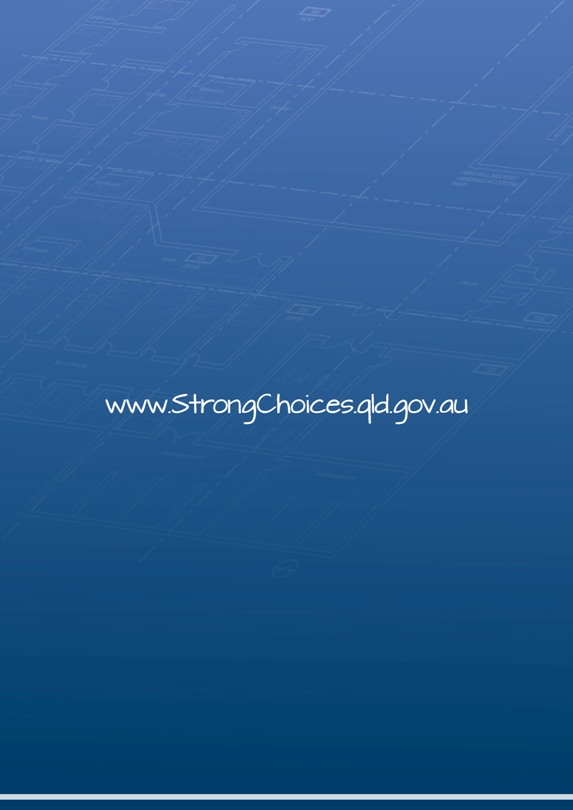
www.StrongChoices.qld.gov.au














































